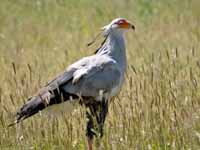THE WORLD BIRDS - An Online Bird Book
RAPTORS - Eagles
Eagles
RAPTORS - Eagles
Raptors are birds of prey. They are carnivorous, long lived, and have low reproductive rates. They catch their prey via strong claws – three pointing forward and one pointing backward. The raptors that hunt by day are: hawks, eagle, kites, vultures, falcons. Owls hunt by night. The raptors are spread over a number of orders: Accipitriformes (hawks and allies), Cathartiformes (New World vultures), Falconiformes (falcons), Strigiformes (owls).
Unlike most other birds, or mammals for that matter, almost all female raptors are larger than their male counterpart. There is no consensus as why evolution worked this way for the raptor. The theory I like best is that the bigger female can defend the nest better, while the smaller male is more agile and can find lots of little prey to bring home to the nest. That is, when the chicks are young, they need lots of little tidbits, not one humungous carcass. A side benefit of having male and female being different in size is that they tend to go after different food sources so that way they are not competing with each other for food. But if males were the bigger ones, that diversity benefit would also be true. So perhaps the overarching reason, is the male bringing home lots of tidbits.
Raptors, especially those that stalk prey from the air, tend to have dark upperparts and lighter underparts. Looking down from above a raptor, the dark upperparts tend to blend in with the ground. While looking from below, the light underparts blend better with the sky.
Many of the raptors have their conservation status listed as something other than Least Concern; that is, there is some concern about their survival. A contributing factor is that raptors need a considerable area to offer them sufficient prey. As habitats degrade, they have less area to patrol, and less prey in the remaining areas, a double whammy. Also, for millennia, raptors have been at the top of the food chain and did not need to worry about their longterm survival. As a result, they have evolved to have few offspring, sometimes only 1. Thus if a population decreases, it is hard for it to recover.
Accipitriformes
The order Accipitriformes is made of of three families: Accipitridae, Pandionidae, and Sagittariidae. Accipitridae contains the hawks, eagles, kites, Old World vultures. Pandionidae only contains one species - the osprey, and Sagittariidae only contains the secretary bird.
Accipitridae
Accipitrine raptors generally have broad wings with rounded ends. As indicated below, the family is divided into 9 subfamilies. The characteristics of each of the subfamilies will be given prior to a description for each of their species. A confusing factor for presenting the subfamilies is that common terms such as eagles or kites do not correspond to a specific subfamily. For example, eagles belong to two different subfamilies and kites to 5 subfamilies!
The Accipitridae family has the following subfamiles:
Aquilinae – booted eagles
Circaetinae – serpent eagles
Harpiinae – forest eagles
Accipitrinae – accipitrine hawks
Buteoninae – buteonine hawks
Harpaginae – harpagine hawks
Melieraxinae – melieraxine hawks
Elaninae – elanine kites
Perninae – honey-buzzards
Gypaetinae – gypaetine vultures and harrier-hawks
Gypinae – Old World vultures
Unlike most other birds, or mammals for that matter, almost all female raptors are larger than their male counterpart. There is no consensus as why evolution worked this way for the raptor. The theory I like best is that the bigger female can defend the nest better, while the smaller male is more agile and can find lots of little prey to bring home to the nest. That is, when the chicks are young, they need lots of little tidbits, not one humungous carcass. A side benefit of having male and female being different in size is that they tend to go after different food sources so that way they are not competing with each other for food. But if males were the bigger ones, that diversity benefit would also be true. So perhaps the overarching reason, is the male bringing home lots of tidbits.
Raptors, especially those that stalk prey from the air, tend to have dark upperparts and lighter underparts. Looking down from above a raptor, the dark upperparts tend to blend in with the ground. While looking from below, the light underparts blend better with the sky.
Many of the raptors have their conservation status listed as something other than Least Concern; that is, there is some concern about their survival. A contributing factor is that raptors need a considerable area to offer them sufficient prey. As habitats degrade, they have less area to patrol, and less prey in the remaining areas, a double whammy. Also, for millennia, raptors have been at the top of the food chain and did not need to worry about their longterm survival. As a result, they have evolved to have few offspring, sometimes only 1. Thus if a population decreases, it is hard for it to recover.
Accipitriformes
The order Accipitriformes is made of of three families: Accipitridae, Pandionidae, and Sagittariidae. Accipitridae contains the hawks, eagles, kites, Old World vultures. Pandionidae only contains one species - the osprey, and Sagittariidae only contains the secretary bird.
Accipitridae
Accipitrine raptors generally have broad wings with rounded ends. As indicated below, the family is divided into 9 subfamilies. The characteristics of each of the subfamilies will be given prior to a description for each of their species. A confusing factor for presenting the subfamilies is that common terms such as eagles or kites do not correspond to a specific subfamily. For example, eagles belong to two different subfamilies and kites to 5 subfamilies!
The Accipitridae family has the following subfamiles:
Aquilinae – booted eagles
Circaetinae – serpent eagles
Harpiinae – forest eagles
Accipitrinae – accipitrine hawks
Buteoninae – buteonine hawks
Harpaginae – harpagine hawks
Melieraxinae – melieraxine hawks
Elaninae – elanine kites
Perninae – honey-buzzards
Gypaetinae – gypaetine vultures and harrier-hawks
Gypinae – Old World vultures
Eagles
This article contains species from the following Accipitridae subfamilies: Aquilinae – booted eagles, Circaetinae – serpent eagles, and Harpiinae – forest eagles. All but the Bateleur and the hawk bat have "eagle" in their name. For most birds of prey, the female is larger than the male. The sea-eagles, also known as fish-eagles, are usually placed by ornithologists in one of the hawk subfamilies: Buteoninae. However, the fish-eagles are placed in this article with the eagles. Placing an iconic bird such as the bald eagle with the hawks would lead to confusion.
Aquilinae – booted eagles
All species in this subfamily have legs that are covered in feathers, which leads to their name - booted eagles. The booted eagles probably separated from other family members millions of years ago. These eagles are medium to large sized raptors.The pygmy eagle weights about 500g while the golden eagle and martial eagles both weigh about 4 kg. Many species have a significant crest. The feet and talons of booted eagle species are often particularly large and powerful relative to their size. They have very good eye-sight.
Booted eagles are found on every continent. with a disproportionate number living in Africa. The majority of the species are forest dwelling, but some prefer tundra, praires, rocky, or mountainous areas. Those that live in open areas tend to seek their prey while flying, while forest dwellers find it more profitable to search while perched in a tree. But they are flexible in their hunting approach and also flexible about what to eat: mammals, other birds, reptiles, or amphibians. There is not a vegetarian in the group as is evident when their bill or feet are examined.
Booted eagles require a large area for their hunting, a dozen square kilometers or more. They defend their territory via aerial displays or voiced threats. Their large nests are usually in trees, but also on the ground. The female incubates the eggs while the male provides her with food. They usually only have 1 to 3 eggs per brood. The hatchings are spread out and the older thus larger sibling often kills the litter mates.
Genus Aquila
This is the genus of "true" eagles. Most are predominantly dark colored, all have feathers on their legs, and their favorite food are small mammals such as rabbits. The smallest of this genus is the Cassin's hawk-eagle weighing up to 1200 gm. The largest is perhaps the wedge-tailed eagle which weighs up to 5300 gm and has been recorded with a wingspan of 284 cm (9ft 4 in).
Eagle,_African Hawk- Aquila spilogaster
Description: The African hawk-eagle has blackish upperparts, white underparts with heavy black streaking, and a white under-tail with black terminal band. The eyes are yellow and the legs are greenish-yellow. Its feathered legs indicate it is a member of the booted-eagle subfamily. The juvenile has brown upperparts and white underparts with rufous streaking. The African hawk-eagle has darker upperparts and heavier streaking than the similar Bonelli's eagle.
Range: Sub-Saharan Africa (tropical).
Habitat: Treed open areas. Avoids evergreen forests.
Diet: Mainly birds; also small mammals, reptiles. Hunts from a perch of from the air. Can spot prey 1 km away.
Conservation status: Least Concern.
Image by: 1) Paul Seligman 2) Ian White - South Africa 2) Chris Eason - South Africa 4) Steve Garvie - KenyaRange: Sub-Saharan Africa (tropical).
Habitat: Treed open areas. Avoids evergreen forests.
Diet: Mainly birds; also small mammals, reptiles. Hunts from a perch of from the air. Can spot prey 1 km away.
Conservation status: Least Concern.


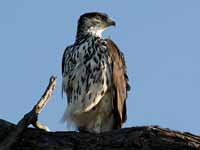

Eagle,_Bonelli's Aquila fasciata
Description: The Bonelli's Eagle has dark brown upperparts. There may be a white patch on the mantle. It has white underparts with dark streaks. The streaks are heaviest on the breast and flanks while there is little streaking on the lower-belly. It has a grey upper-tail. The white under-tail has a single black terminal band. The feet and eyes are yellow. Its feathered legs indicate it is a member of the booted-eagle subfamily. It often perches with a very upright carriage. The similar African hawk-eagle has darker upperparts and heavier streaking than the Bonelli's eagle.
Range: Europe (southern), Asia (southern), Africa (northwestern).
Habitat: Near large bodies of water, usually in arid climates. Also rocky terrain.
Diet: Birds and mammals. Favors squirrels, rabbits, pigeons. Mostly captures prey on the ground, but some birds are captured in flight.
Conservation status: Least Concern.
Image by: 1) Seshardri KS - India 2) Andy Li 3) Imran_Shah - PakistanRange: Europe (southern), Asia (southern), Africa (northwestern).
Habitat: Near large bodies of water, usually in arid climates. Also rocky terrain.
Diet: Birds and mammals. Favors squirrels, rabbits, pigeons. Mostly captures prey on the ground, but some birds are captured in flight.
Conservation status: Least Concern.
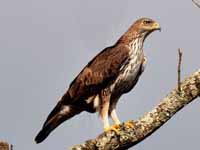
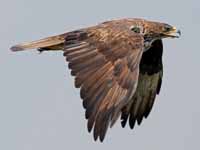
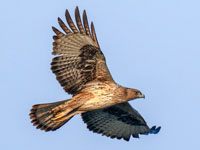 f
fEagle,_Cassin's Hawk- Aquila africana
Description: The Cassin's hawk-eagle has greyish-black upperparts with some white patches. The underparts are white. The under-wing coverts are black, while across the primary and secondaries there are two dark bands and a dark terminal band. The tail has 3 dark bands, plus a dark terminal band. It has pale yellow feet and a black bill. Cassin's hawk-eagle is the smallest of the Aquila eagles. The second smallest is the African hawk-eagle. Calling them "hawk-eagles" emphasizes their small size.
Range: Africa (west-central).
Habitat: Rain forests where it is rarely seen. It perches in the canapy or soars above the trees looking for prey. The nests are high in the trees.
Diet: Birds, squirrels.
Conservation status: Least Concern.
Image by: 1) Joseph Mochoge - Kenya Range: Africa (west-central).
Habitat: Rain forests where it is rarely seen. It perches in the canapy or soars above the trees looking for prey. The nests are high in the trees.
Diet: Birds, squirrels.
Conservation status: Least Concern.
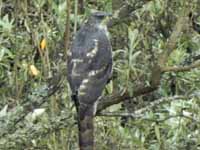
Eagle,_Golden Aquila chrysaetos
Description: The golden eagle is a very large raptor, females can weigh over 6 kg. It has dark brown plumage; lighter golden brown on head and neck. The bill is mainly yellow with a black tip. The legs and feet are yellow. It is a very efficient hunter, having a range of speeds and is agile. Its nesting territory is large - about 20 km. Juveniles have white patches on wings and tail which helps differentiate them from juvenile bald eagles.
Range: North America, Europe, Asia, northern Africa. Breeds mainly in North America.
Habitat: Sea level to high mountains. Likes relative open habitat, but also found in forested landscapes. Nests are usually off the ground on cliffs or in trees.
Diet: Birds, small mammals; especially rabbits, squirrels, prairie dogs. Scavenges, especially in winter. It is capable of taking down live stock.
Conservation status: Least Concern.
Image by: 1) BlueRidgeKitties - North Carolina 2, 4) Dick Daniels - Carolina
Raptor Center 3) J. Glover of Atlanta,
Georgia 5) Juan_lacruz - Spain 6) Imram_Shah - PakistanRange: North America, Europe, Asia, northern Africa. Breeds mainly in North America.
Habitat: Sea level to high mountains. Likes relative open habitat, but also found in forested landscapes. Nests are usually off the ground on cliffs or in trees.
Diet: Birds, small mammals; especially rabbits, squirrels, prairie dogs. Scavenges, especially in winter. It is capable of taking down live stock.
Conservation status: Least Concern.


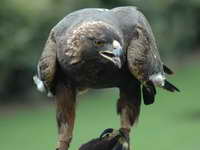
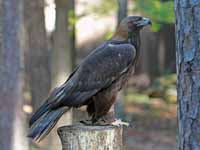
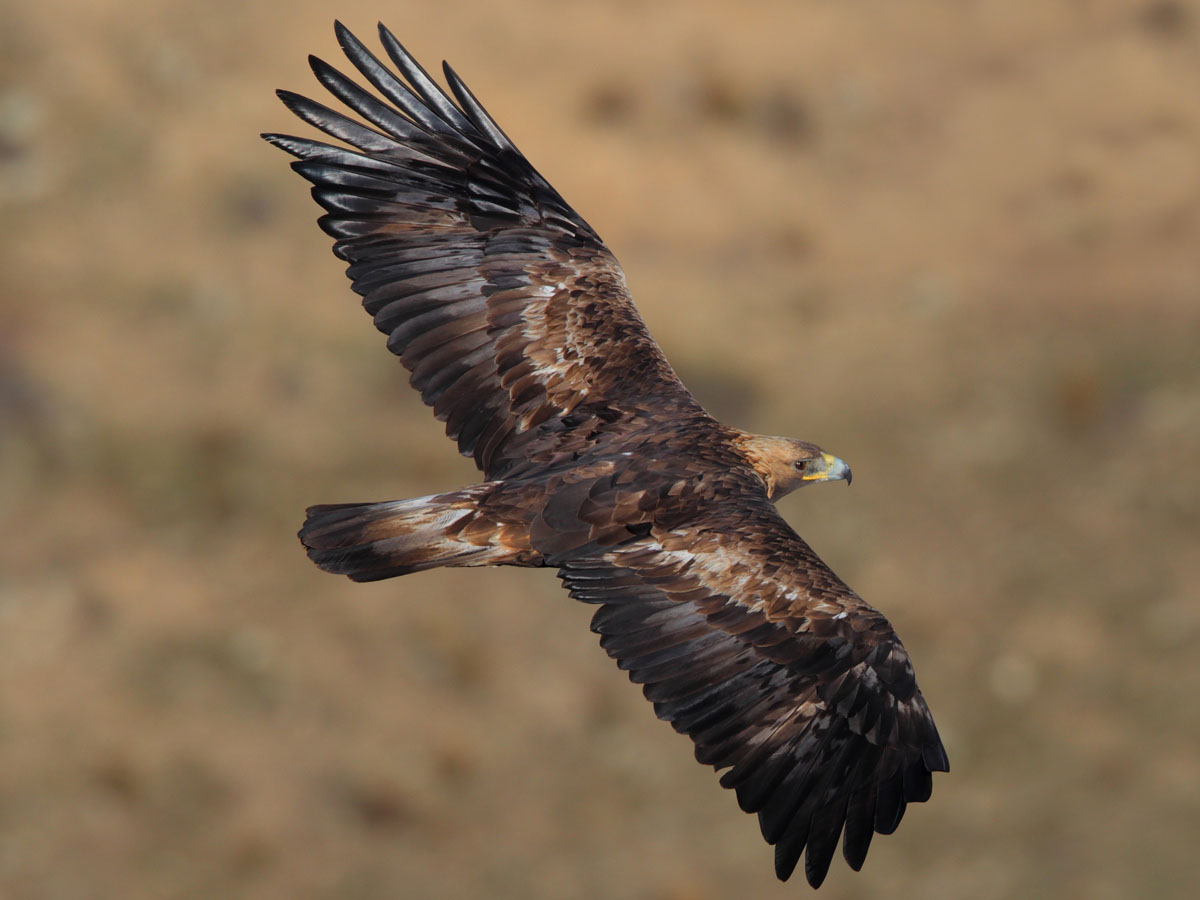

Eagle,_Gurney's Aquila gurneyi
Description: The Gurney's eagle has dark brown to black upperparts and light brown to white underparts. It has a rounded tail. It has dark under-wing covers and primaries with lighter secondaries. For the Aquila genus it is a medium sized eagle, but that implies it is a large raptor.
Range: New Guinea and nearby islands.
Habitat: Wide range of habitats from sea level to the snow line.
Diet: Mammals, reptiles, fish, and birds.
Conservation status: The Gurney's eagle is consider Near Threatened. It is seen only infrequently and knowledge about its population is lacking.
Image by: 1) Joseph Wolf Range: New Guinea and nearby islands.
Habitat: Wide range of habitats from sea level to the snow line.
Diet: Mammals, reptiles, fish, and birds.
Conservation status: The Gurney's eagle is consider Near Threatened. It is seen only infrequently and knowledge about its population is lacking.

Eagle,_Imperial Aquila heliaca
Description: The imperial eagle, also known as the eastern imperial eagle, has mainly dark brown upperparts with white shoulder patches. It has a light brown head, neck, and underparts. The head and neck may have gold tinge. The bill is grey with a yellow cere and a dark tip. It is usually the darkest eagle in its range.
Range: Europe, Asia, Africa.
Habitat: Interface of tall trees and flat open spaces. Nests in large trees.
Diet: Mammals, birds, reptiles, carrion.
Conservation status: Vulnerable. This eagle used to be very plentiful, but there are now less than 10,000 due to removal of large trees along field boundaries that were used as nest sites.
Image by: 1) Sumeet_Moghe 2) AngMoKio 3) Sergey Pisarevskiy - South Siberia, Russia 4) Koshy_Koshy 5) Bernd_ThallerRange: Europe, Asia, Africa.
Habitat: Interface of tall trees and flat open spaces. Nests in large trees.
Diet: Mammals, birds, reptiles, carrion.
Conservation status: Vulnerable. This eagle used to be very plentiful, but there are now less than 10,000 due to removal of large trees along field boundaries that were used as nest sites.
1) Juvenile
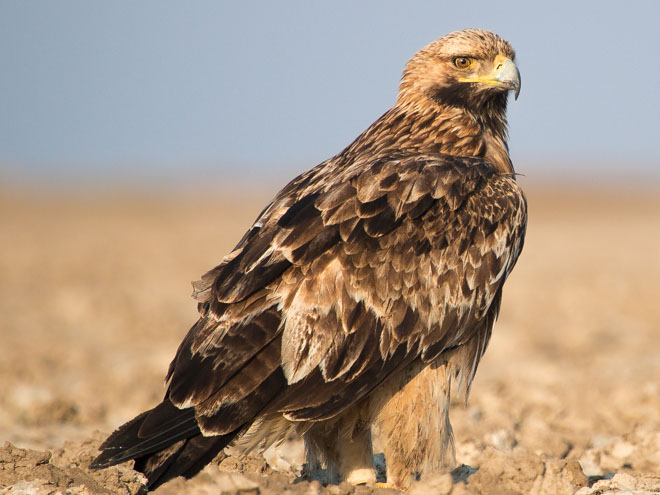

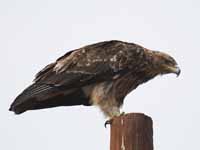
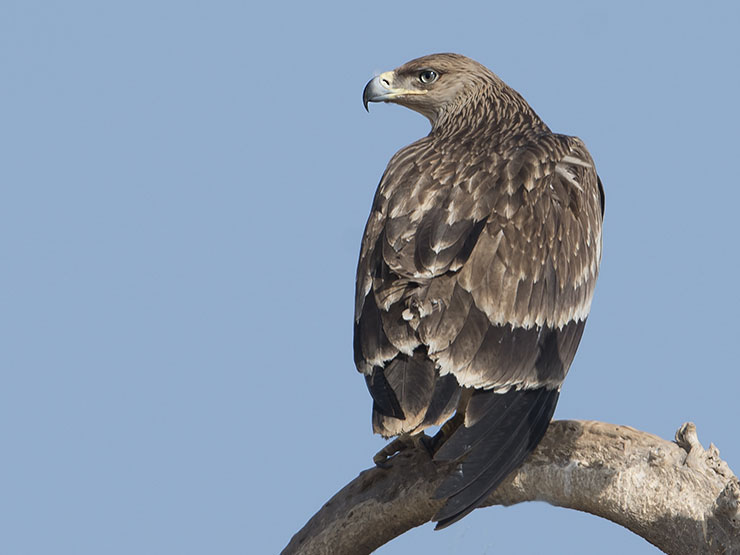
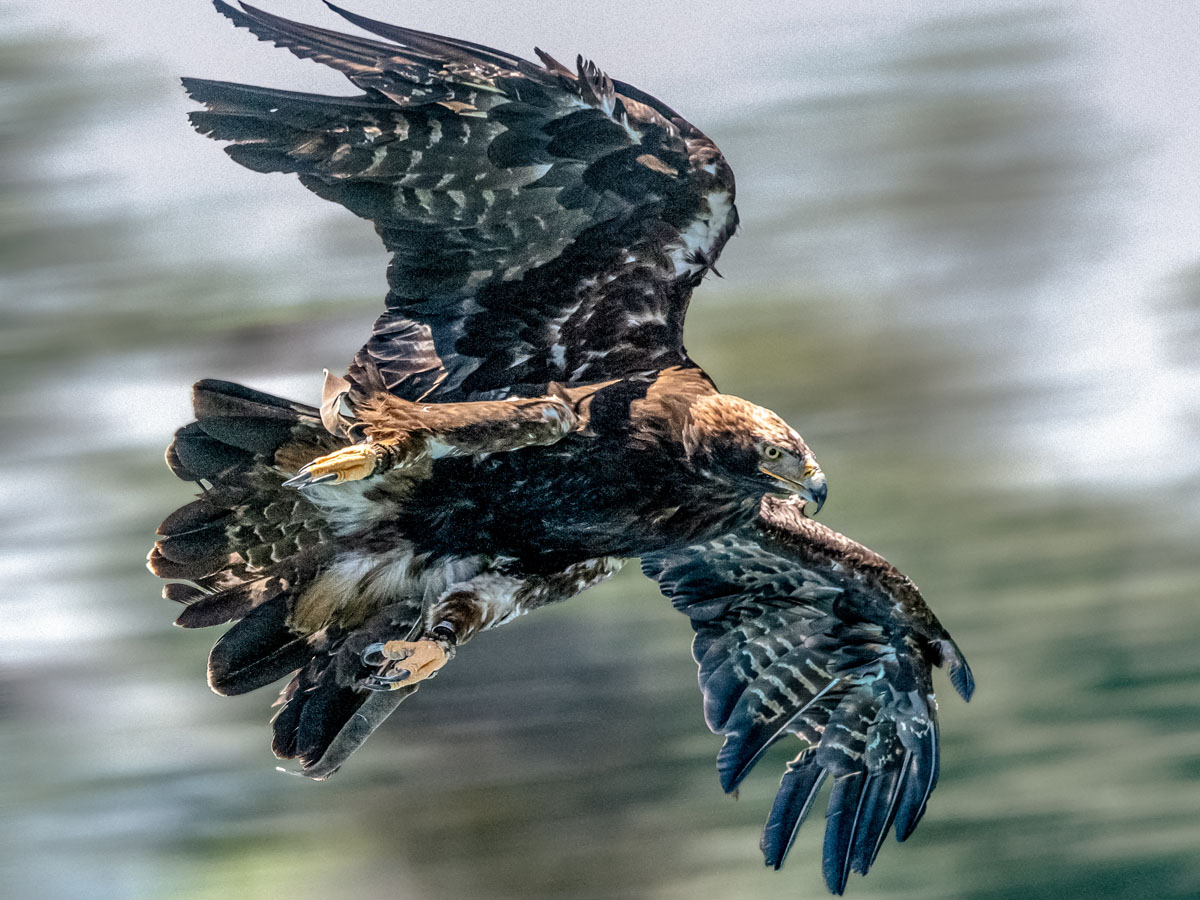
Eagle,_Spanish Aquila adalberti
Description: The Spanish eagle, also known as the Spanish imperial eagle, has mainly dark brown upperparts with white shoulder patches. The head and neck are light brown. The underparts are light or dark brown depending on morph. It has a light grey bill with yellow cere and darker tip. The primaries and secondaries are blackish-brown. It has a rounded tail.
Range: Central and south-west Spain, adjacent areas of Portugal.
Habitat: Used to prefer forested areas with dry summers and rainy winters. Since introducing chicks into the wild, more are living in the plains.
Diet: Mammals, especially rabbits; also birds.
Conservation status: The Spanish eagle is Vulnerable due to declines in its main prey, rabbits, and also collusions with power lines. Conservation efforts have increased its population from less than 100 birds.
Image by: 1) Antonio Gomez 2) Rodrigo_Argenton Range: Central and south-west Spain, adjacent areas of Portugal.
Habitat: Used to prefer forested areas with dry summers and rainy winters. Since introducing chicks into the wild, more are living in the plains.
Diet: Mammals, especially rabbits; also birds.
Conservation status: The Spanish eagle is Vulnerable due to declines in its main prey, rabbits, and also collusions with power lines. Conservation efforts have increased its population from less than 100 birds.
1) Juvenile


Eagle,_Steppe Aquila nipalensis
Description: The steppe eagle is a large eagle with brown upperparts and blackish flight feathers and tail. The bill has a black tip and yellow cere. It has a square tail. The dark morph tawny eagle can be confused with a steppe eagle. The tawny eagle has uniformly dark upperparts while the steppe eagle has wings that are darker than its back.
Range: Europe, Asia, Africa.
Habitat: The steppes are mostly treeless, as a result most of their nests are on the ground.
Diet: Mammals such as rabbits, birds. In the winter it eats more insects.
Conservation status: The steppe eagle is Endangered because increased fires on the steppes, more pests around the nests, including human disturbances.
Image by: 1) Patricia van Casteren 2) Sumeet_Moghe 3) Andy Li 4) Sergey Pisarevskiy - South Siberia, Russia Range: Europe, Asia, Africa.
Habitat: The steppes are mostly treeless, as a result most of their nests are on the ground.
Diet: Mammals such as rabbits, birds. In the winter it eats more insects.
Conservation status: The steppe eagle is Endangered because increased fires on the steppes, more pests around the nests, including human disturbances.
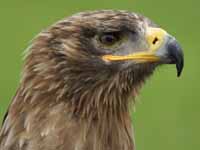
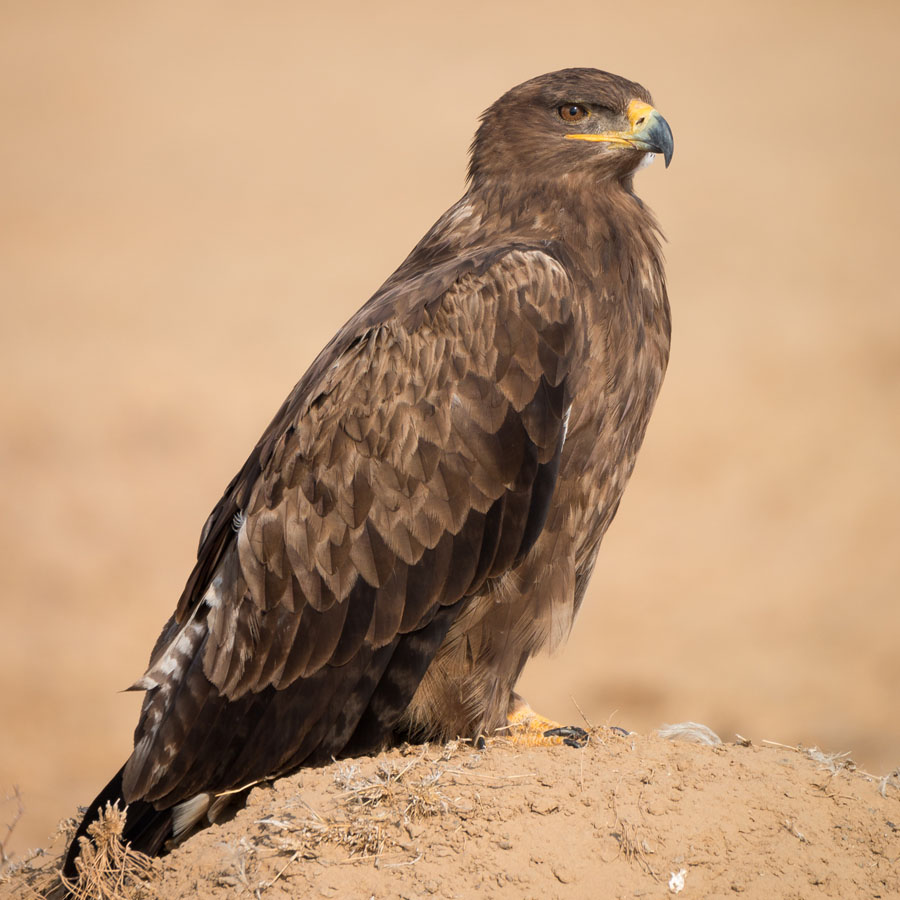

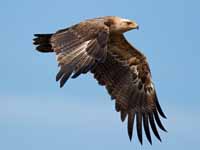
Eagle,_Tawny Aquila rapax
Description: The tawny eagle has several morphs, from light to dark. Most are either dark greyish-brown or lighter tawny. The tail end is almost flat. The dark morph tawny eagle can be confused with a steppe eagle. The tawny eagle has uniformly dark upperparts while the steppe eagle has wings that are darker than its back.
Range: Asia (mainly Indian subcontinent), Africa (south of Sahara).
Habitat: Because they live in diverse areas, they have adapted to diverse habitats; however they do not live in forests or deserts.
Diet: Small mammals, birds, reptiles, carrion.
Conservation status: The tawny eagle has a Vulnerable status. Its population is declining, mainly due to poisoning. As an example, elephant poachers sometimes poison the elephants so scavengers will not fly over the carcas and alert wildlife protectors.
Image by: 1) Yathin Krishnappa 2, 5)
Arno Meintjes 3, 4) Koshy_Koshy - India Range: Asia (mainly Indian subcontinent), Africa (south of Sahara).
Habitat: Because they live in diverse areas, they have adapted to diverse habitats; however they do not live in forests or deserts.
Diet: Small mammals, birds, reptiles, carrion.
Conservation status: The tawny eagle has a Vulnerable status. Its population is declining, mainly due to poisoning. As an example, elephant poachers sometimes poison the elephants so scavengers will not fly over the carcas and alert wildlife protectors.
1, 2) Light morph 3 - 5) Dark morph


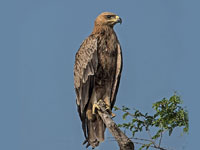
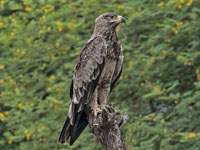
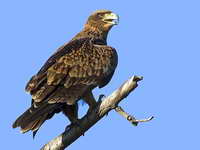
Eagle,_Verreaux's Aquila verreauxii
Description: The Verreaux's eagle, also known as the black eagle, has mainly black plumages, a white rump, brown eyes, a yellow eye-ring and yellow feet. It has a grey bill with yellow cere. The tail is rounded. The wing primaries are white with black tips, secondaries are black on top and white with black tips underneath. The wing coverts are black. Juveniles are usually light and dark brown with a black face and light crown.
Range: Southern and eastern Africa; nearby western Asia.
Habitat: Dry, rocky environment.
Diet: Mammals, especially hyraxes. Also birds, reptiles.
Conservation status: Least Concern.
Image by: 1, 2) Dick Daniels - Radical Raptors, South Africa 3. 4) Derek_Keats - South AfricaRange: Southern and eastern Africa; nearby western Asia.
Habitat: Dry, rocky environment.
Diet: Mammals, especially hyraxes. Also birds, reptiles.
Conservation status: Least Concern.



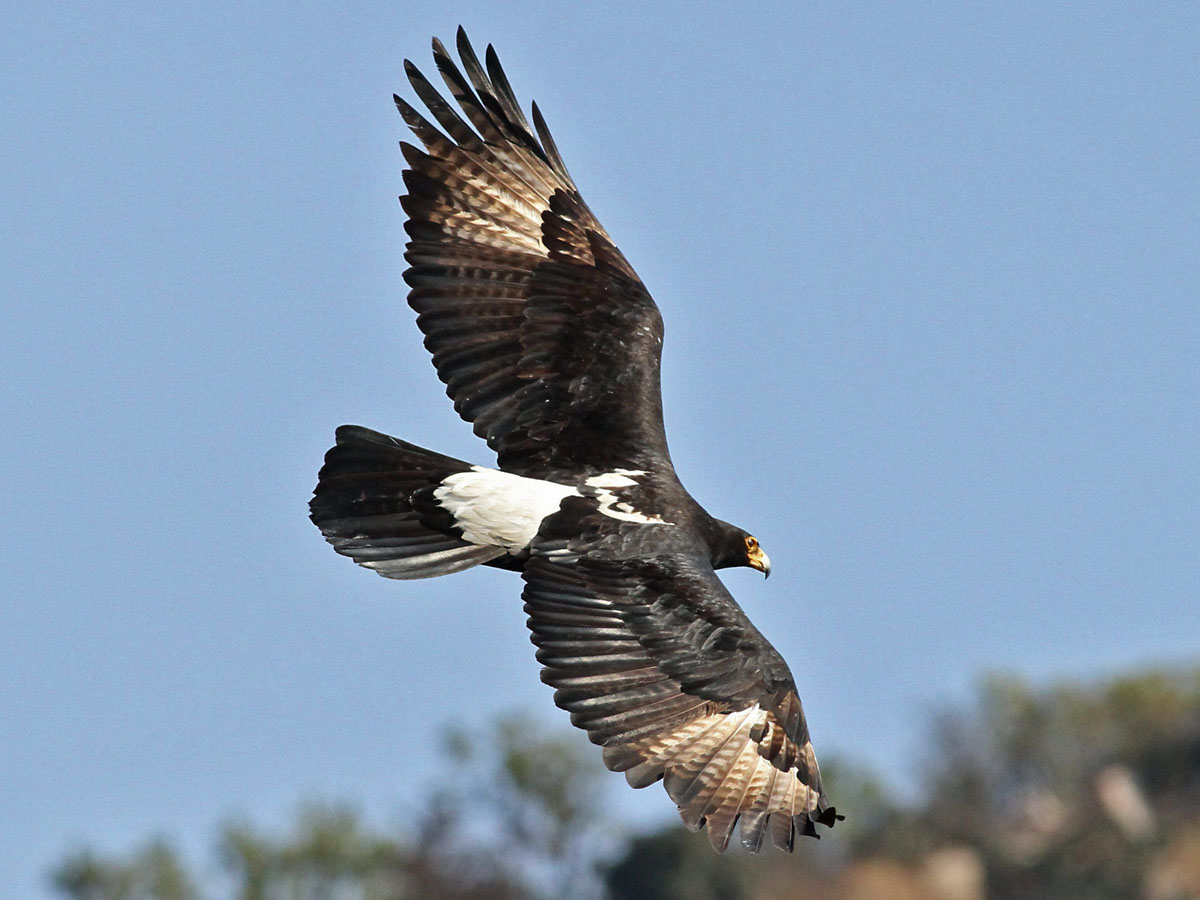
Eagle,_Wedge-tailed Aquila audax
Description: The wedge-tailed eagle has a unique wedge shaped tail when seen in flight. It has mainly black plumage, a rufous nape, and pale legs. Young eagles are a mid-brown colour with slightly lighter and reddish-brown wings and head. As they grow older, their colour becomes darker, reaching a dark blackish-brown shade after about ten years. Of all the eagles, the wedge-tailed eagle has the largest verified recorded wingspan: 284 cm (9 ft 4 in). Their wings are unusually elongated for their weight, so they are not also the heaviest of eagle, just in the top 10. They also have very long legs.
Range: Australasia.
Habitat: Diversified habitats but avoids dense forest and people. Nests in wooded areas.
Diet: Mammals (especially rabbits), birds, reptiles, carrion.
Conservation status: Least Concern.
Image by: 1) David Cook - Queensland 2) Brian_McCauley
3) Oystercatcher - New South Wales 4) Fir0002 - VictoriaRange: Australasia.
Habitat: Diversified habitats but avoids dense forest and people. Nests in wooded areas.
Diet: Mammals (especially rabbits), birds, reptiles, carrion.
Conservation status: Least Concern.
3) Note the long tail 4) Note the long legs
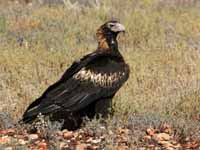
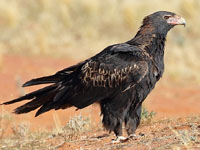

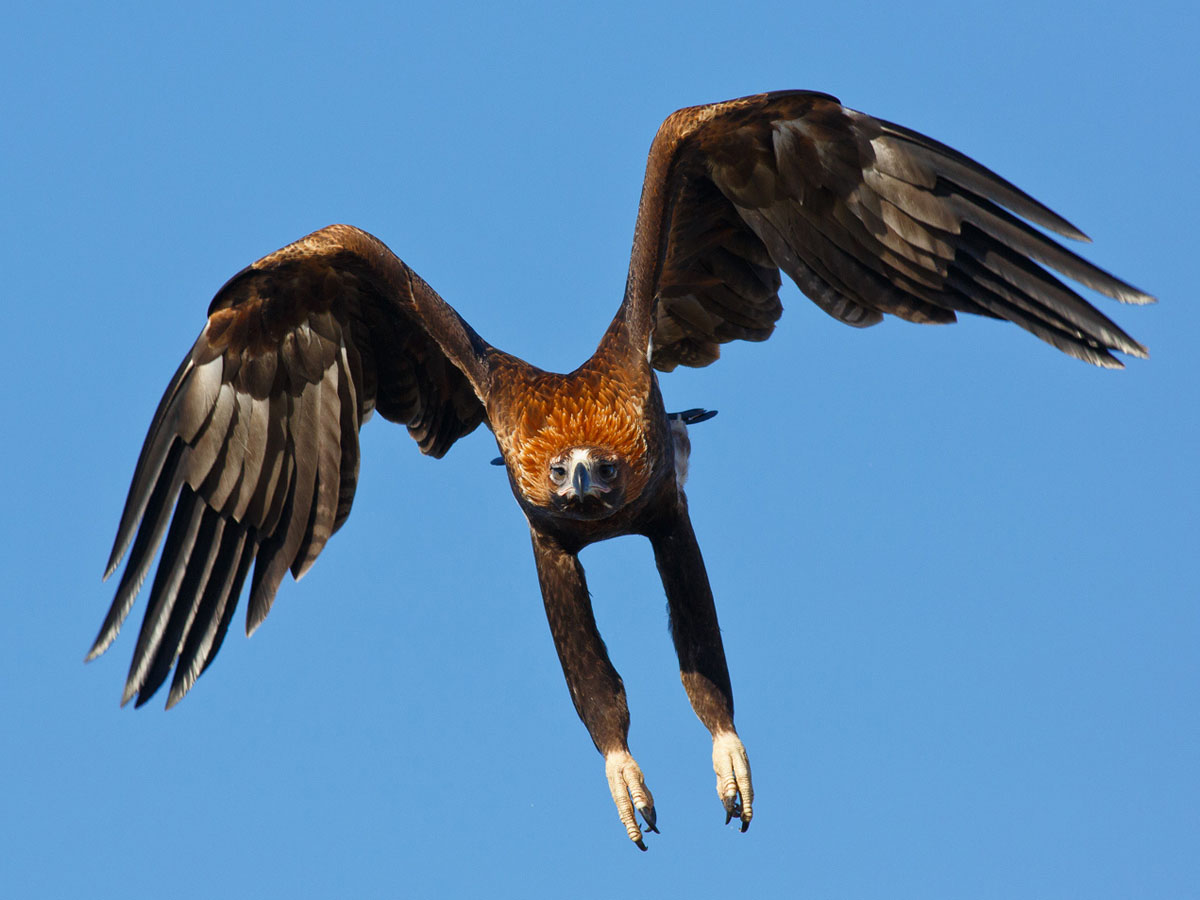
Genus Clanga
Eagle,_Greater Spotted Clanga clanga
Description: The greater spotted eagle, also placed in Aquila clanga, has mainly dark brown or light brown plumage depending on the morph. It has a black tipped bill with yellow cere. It is easy to confuse the lesser spotted eagle and greater spotted eagle. If seen in India, then it is the greater spotted eagle.
Range: Europe, Asia, Africa
Habitat: Forests bordering wetlands. In the winter, visits garbage sites.
Diet: Mammals, reptiles, fish, carrion.
Conservation status: It is Vulnerable because of habitat loss and humans disturbing nesting site. Less than 5000 population.
Image: 1, 2) Koshy_Koshy - Indiadark morph 3) Hari_Patibanda - IndiaRange: Europe, Asia, Africa
Habitat: Forests bordering wetlands. In the winter, visits garbage sites.
Diet: Mammals, reptiles, fish, carrion.
Conservation status: It is Vulnerable because of habitat loss and humans disturbing nesting site. Less than 5000 population.
1, 2) Dark morph



Eagle,_Indian Spotted Clanga hastata
Description: The Indian spotted eagle, also identified as Aquila hastata, has mainly light brown plumage. The primary flight feathers are black. The Indian spotted eagle has lighter color than the similar lesser spotted eagle.
Range: Bangladesh, India, Myanmar, Nepal.
Habitat: Sparse forests bordered by grasslands, parks, and other open areas. Tropical and subtropical climates.
Diet: Mammals, birds, reptiles, frogs.
Conservation status: Its status is Vulnerable because of declining population from habitat loss. The population is thought to be under 10,000.
Image by: 1) Ravi Vaidyanathan 2) ChinmayiskRange: Bangladesh, India, Myanmar, Nepal.
Habitat: Sparse forests bordered by grasslands, parks, and other open areas. Tropical and subtropical climates.
Diet: Mammals, birds, reptiles, frogs.
Conservation status: Its status is Vulnerable because of declining population from habitat loss. The population is thought to be under 10,000.

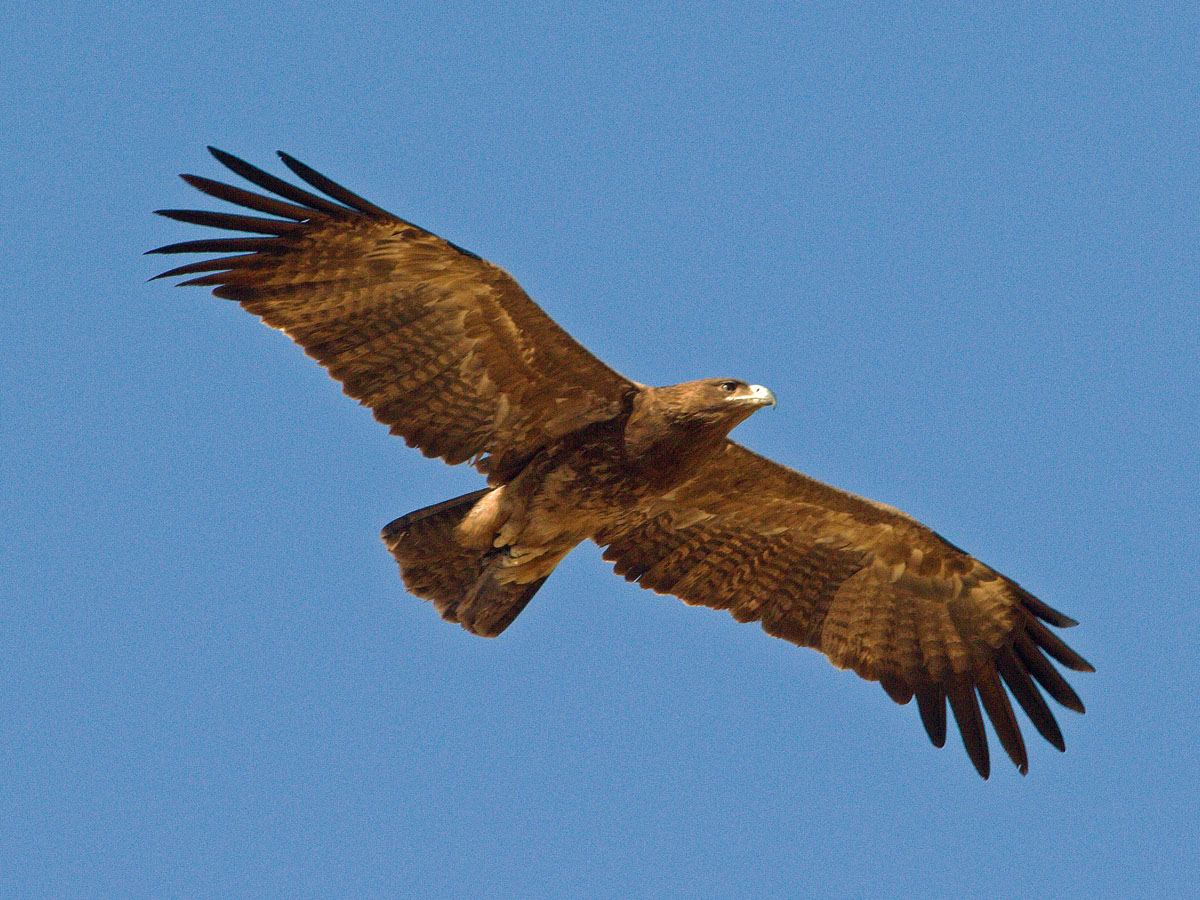
Eagle,_Lesser Spotted Clanga pomarina
Description: The lesser spotted eagle, also identified as Aquila pomarina, has mainly brown plumage with the head darker; and a white V at base of upper-tail. The wing-coverts are lighter brown than the rest of the body. It is easy to confuse the lesser spotted eagle and greater spotted eagle. If seen in India, then it is the greater spotted eagle. Also, the lesser spotted eagle has a prominent white V at base of upper-tail, the greater spotted eagle does not. The similar Indian spotted eagle has lighter color than the lesser spotted eagle.
Range: Europe, Africa, western Asia.
Habitat: Sparse forests bordered by grasslands, parks, and other open areas.
Diet: Mammals, birds, reptiles, frogs.
Conservation status: Least Concern.
Image by: 1) Steve Groom 2) Wolbrum_avner 3) Dominic_Sherony. 3) Artur Mikotajewski - Poland Range: Europe, Africa, western Asia.
Habitat: Sparse forests bordered by grasslands, parks, and other open areas.
Diet: Mammals, birds, reptiles, frogs.
Conservation status: Least Concern.
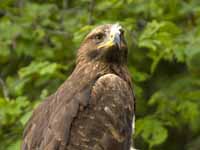

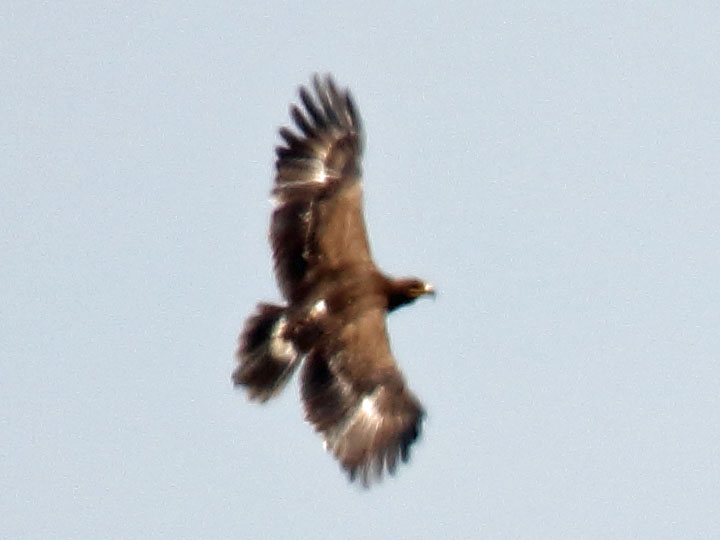
Genus Hieraaetus
Eagle,_Ayres's Hawk- Hieraaetus ayresii
Description: The Ayres's hawk-eagle has brown upperparts; white underparts with black streaks; barred under-wings. The male has a white forehead, throat, and chin. Female has much less white on the head. A dark morph has a dark head and underparts.
Range: Africa.
Habitat: Deciduous woodlands of central Africa when trees are bare. During rainy season, when leaves emerge, moves to treed savanna further south. Builds nest in trees.
Diet: Mainly birds such as doves and pigeons; also mammals. Usually attacks while soaring; also from perch.
Conservation status: Least Concern.
Image by: 1) Male Johann du Preez - ZImbabwe 2) Dark morph Nik_Borrow - Ethiopia 3) George_Wilson - BotswanaRange: Africa.
Habitat: Deciduous woodlands of central Africa when trees are bare. During rainy season, when leaves emerge, moves to treed savanna further south. Builds nest in trees.
Diet: Mainly birds such as doves and pigeons; also mammals. Usually attacks while soaring; also from perch.
Conservation status: Least Concern.
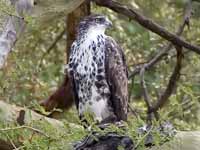

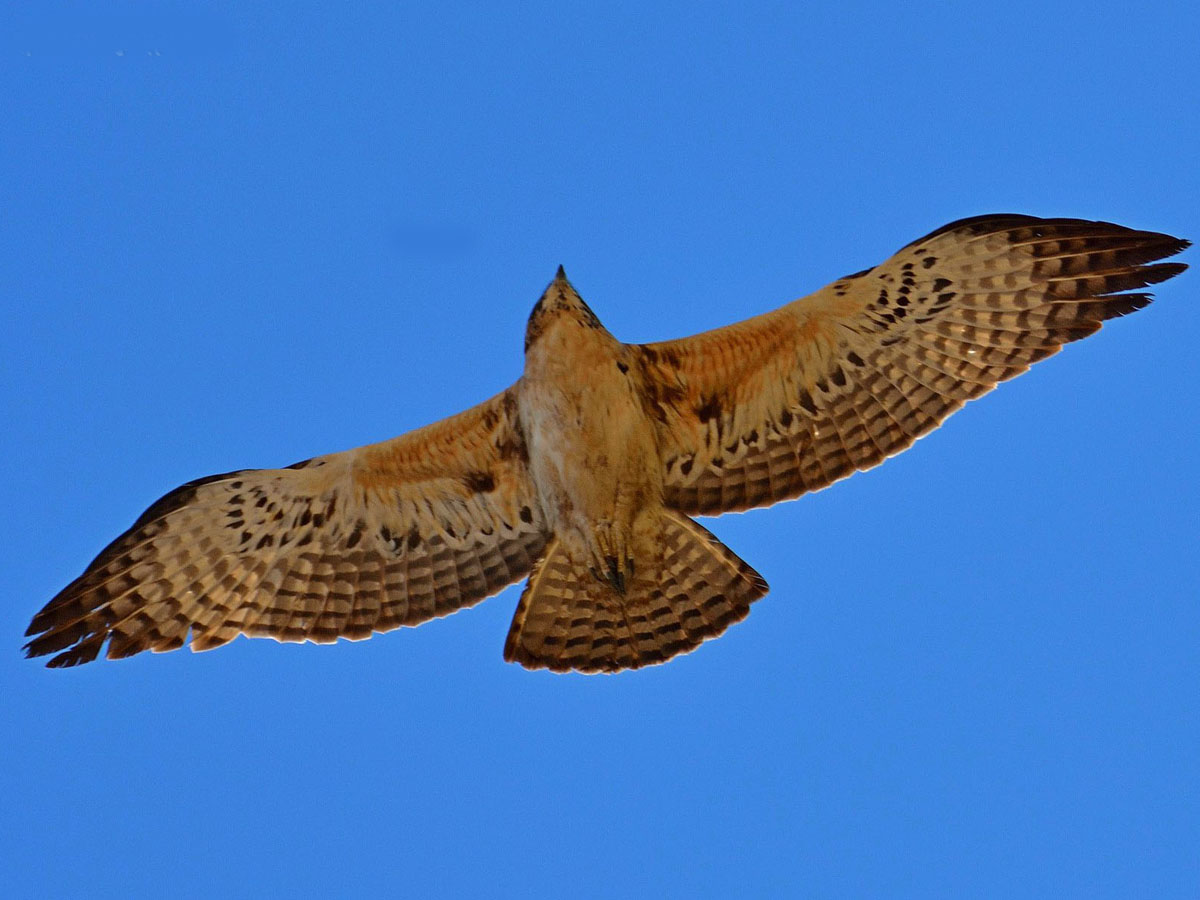
Eagle,_Booted Hieraaetus pennatus
Description: The booted eagle has two forms. Pale has mainly light grey plumage with darker head and flight feathers. Other form has brown plumage with dark grey flight feathers. The booted eagle is small for an eagle, the largest being about 1 kg (2.2 lbs).
Range: Europe, Asia, Africa.
Habitat: Woods with open areas. Nest in trees. Female guards nest, male brings her and chicks food. Most migrate, except for those in southern Africa.
Diet: Birds, mammals, reptiles.
Conservation status: Least Concern.
Image by:1) Subramanya_CK 2) Lip Kee Yap 3) Muchaxo - Portugal 4) Imram_Shah - PakistanRange: Europe, Asia, Africa.
Habitat: Woods with open areas. Nest in trees. Female guards nest, male brings her and chicks food. Most migrate, except for those in southern Africa.
Diet: Birds, mammals, reptiles.
Conservation status: Least Concern.
1) Dark morph 2 - 4) Pale morph
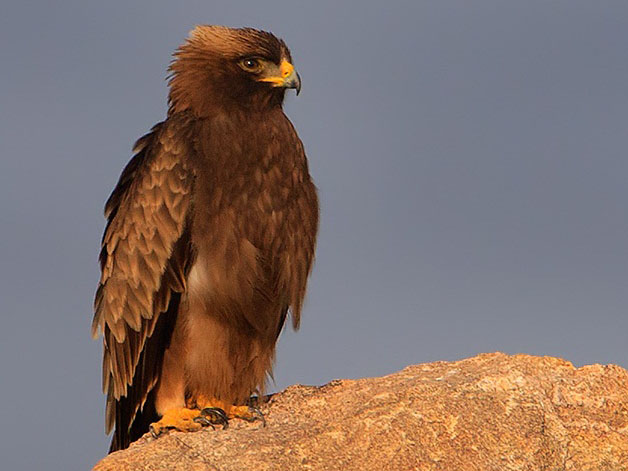
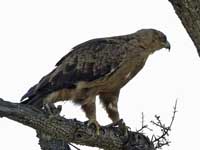

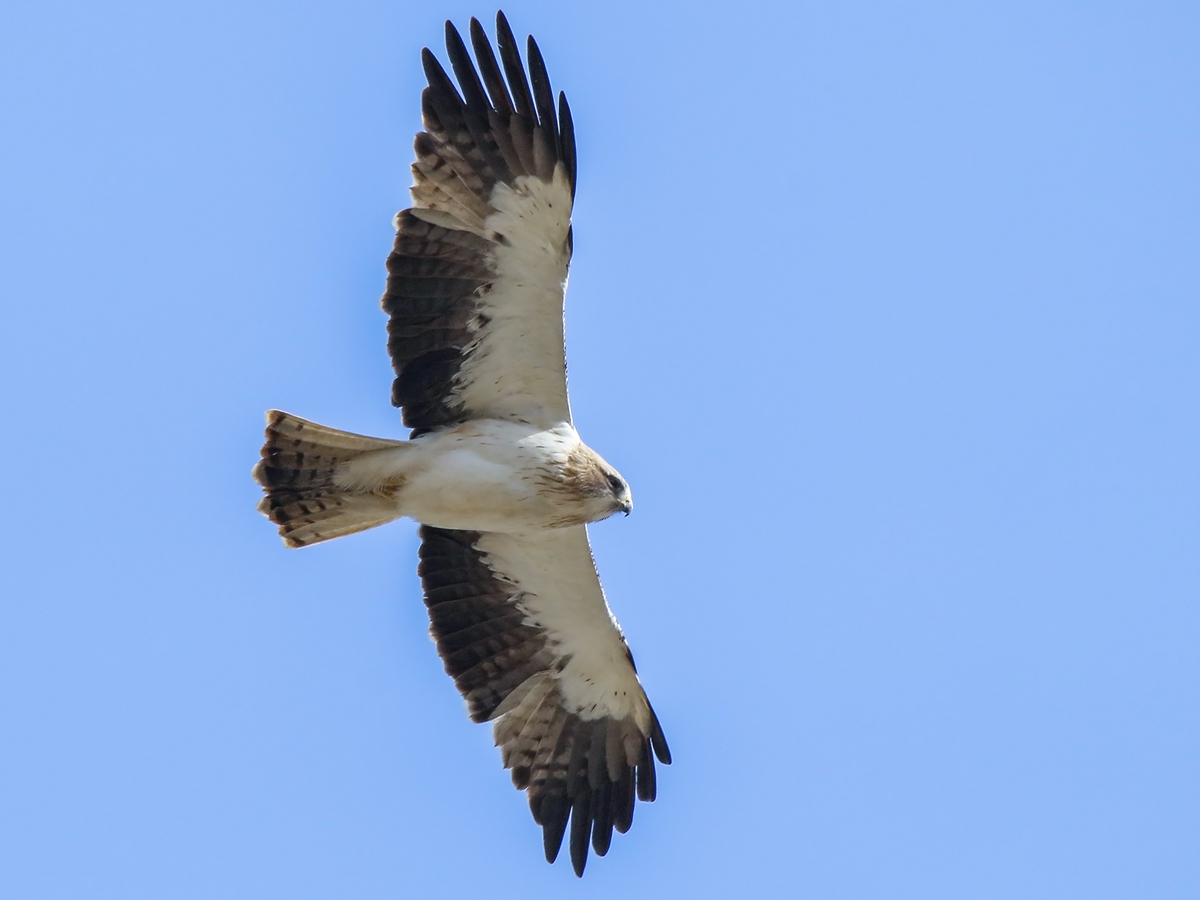
Eagle,_Little Hieraaetus morphnoides
Description: The little eagle weighs under a kg (2 lbs). It has a light form and dark form. The light form has brown upperparts with white mottling plus lighter brown head and underparts. The dark form has a darker head.
Range: Australia.
Habitat: Avoids treeless areas or dense forests.
Diet: Mammals, birds, reptiles, carrion.
Conservation status: Least Concern.
Image by: 1) Jean_and_Fred 2) birdsaspoetry 3) Paul HitchRange: Australia.
Habitat: Avoids treeless areas or dense forests.
Diet: Mammals, birds, reptiles, carrion.
Conservation status: Least Concern.
1) Dark form 2, 3) Light form
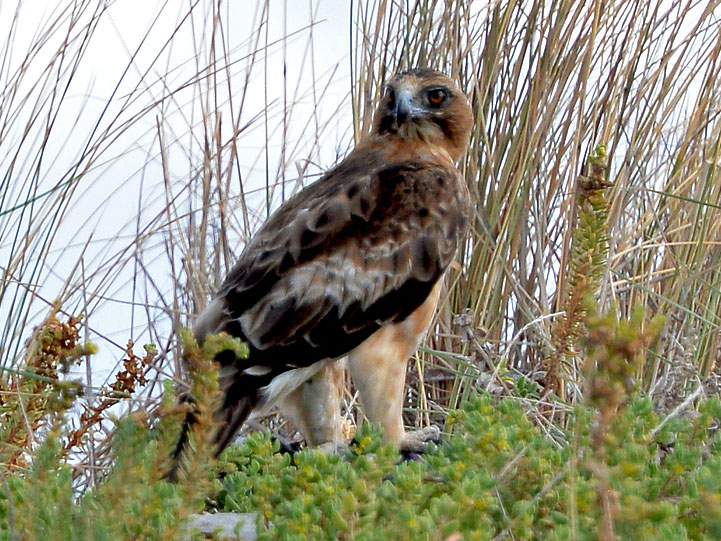
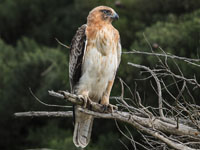
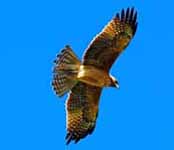
Eagle,_Pygmy Hieraaetus weiskei
Description: The pygmy eagle has a brown streaked head and nape. The tail is barred. It is even smaller than its close Australian relative the little eagle. It has two morphs, but almost all are of the pale type. This has pale under-wing coverts and a white breast with dark streaks. Ths dark morph has brown under-wing coverts.
Range: New Guinea.
Habitat: Open forests and forest edges.
Diet: Birds. It soars and then dives when a prey is spotted.
Conservation status: Least Concern.
Image by: 1) Sergey_Yeliseev 2) David_MitchellRange: New Guinea.
Habitat: Open forests and forest edges.
Diet: Birds. It soars and then dives when a prey is spotted.
Conservation status: Least Concern.

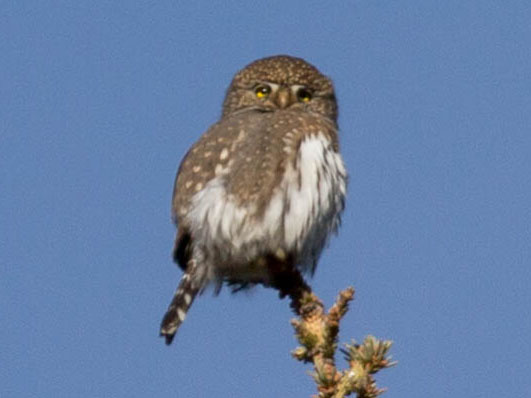
Eagle,_Wahlberg's Hieraaetus wahlbergi
Description: The Wahliberg's eagle is light brown (intermediate morph), dark brown (dark morph), and rarely white. The head has a small crest and the legs are yellow. The gape only extends at maximum to the middle of the eye, whereas in lesser spotted eagle it extends to the back of the eye.
Range: Sub-Saharan Africa.
Habitat: Open woodlands and treed savanna.
Diet: Mainly reptiles; also birds, mammals.
Conservation status: Least Concern.
Image by: 1) Doug Newman - Kruger National Park, South Africa 2) Ian
White 3) Darren Bellerby -
Maasai Mara, KenyaRange: Sub-Saharan Africa.
Habitat: Open woodlands and treed savanna.
Diet: Mainly reptiles; also birds, mammals.
Conservation status: Least Concern.
1, 2) Intermediate morph 3) Dark morph

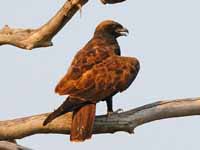
Genus Ictinaetus - 1 species
Eagle,_Black Ictinaetus malaiensis
Description: The black eagle has all black plumage. It has a yellow bill base (cere) and yellow feet. Note: Verreaux's eagle is also sometimes called "Black Eagle", but that bird is restricted to Africa.
Range: South and southeast Asia.
Habitat: At or near forests, especially edges and clearings.
Diet: Mammals such as squirrels and bats. Also birds and their eggs. Along with swallow-tailed kites they share the unique habit of carrying away an entire nest with nestlings to a feeding perch.
Conservation status: Least Concern.
Image by: 1) Tarique Sani - India 2) Kalyanvarma 3) Jim_Cox - IndiaRange: South and southeast Asia.
Habitat: At or near forests, especially edges and clearings.
Diet: Mammals such as squirrels and bats. Also birds and their eggs. Along with swallow-tailed kites they share the unique habit of carrying away an entire nest with nestlings to a feeding perch.
Conservation status: Least Concern.


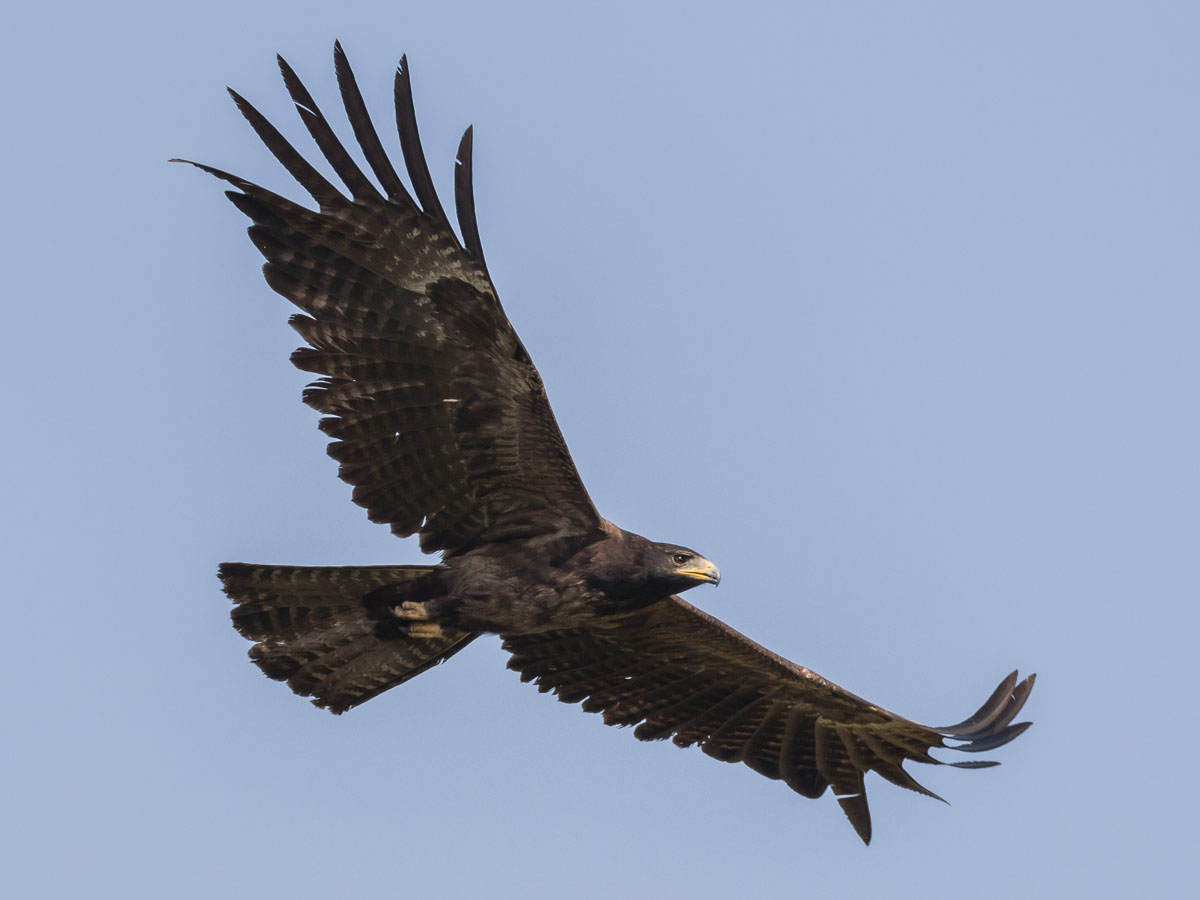
Genus Lophaetus - 1 species
Eagle,_Long-crested Lophaetus occipitalis
Description: The long-crested eagle has a very long crest, mainly dark brown to black plumage, and grey barred tail. It has yellow feet and a black tipped bill with yellow cere.
Range: Sub-Saharan Africa.
Habitat: Open woodland, especially if near open area or waterbodies.
Diet: Mostly rodents; also birds.
Conservation status: Least Concern.
Image by: 1, 2) Dick Daniels - Kenya 3) Derek_KeatsRange: Sub-Saharan Africa.
Habitat: Open woodland, especially if near open area or waterbodies.
Diet: Mostly rodents; also birds.
Conservation status: Least Concern.


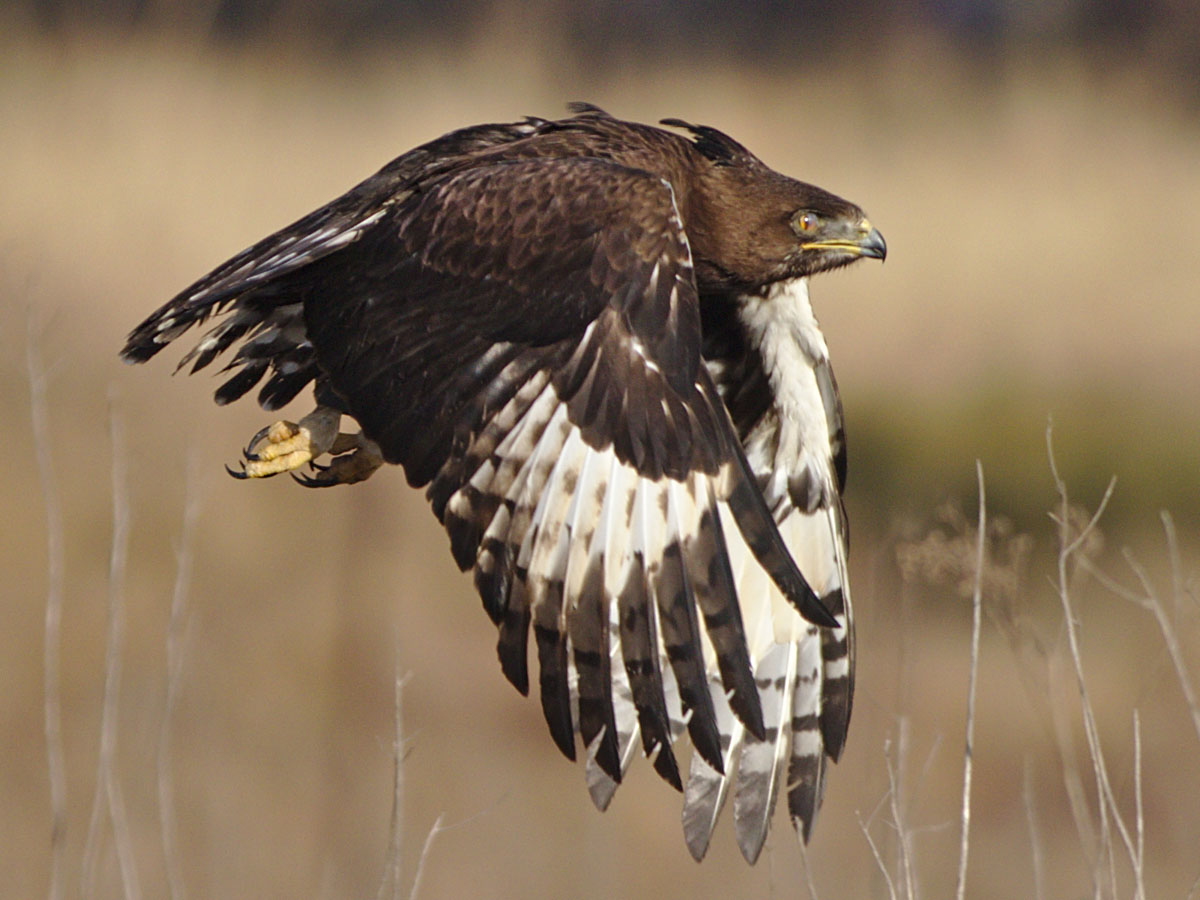
Genus Lophotriorchis - 1 species
Eagle,_Rufous-bellied Lophotriorchis kienerii
Description: The rufous-bellied eagle has a dark hood, white throat, and white breast with dark streaks on the edges. The belly is rufous with dark streaks and the legs are pale rufous.
Range: tropical Asia.
Habitat: Mainly in moist forests.
Diet: Birds and mammals. Dives to catch prey near the ground or on tree-tops.
Conservation status: It is Near Threatened. Population less then 10,000 but difficult to determine how much less. Deforestation is its major challenge.
Image by: 1) Magalhães 2) Shrikant_raoRange: tropical Asia.
Habitat: Mainly in moist forests.
Diet: Birds and mammals. Dives to catch prey near the ground or on tree-tops.
Conservation status: It is Near Threatened. Population less then 10,000 but difficult to determine how much less. Deforestation is its major challenge.
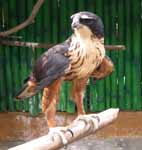

Genus Nisaetus
The hawk-eagles are found mainly in tropical Asia. They are slender bodied, medium sized eagles with rounded wings, long feathered legs, barred wings, crests and usually adapted to forest habitats. They have large bills and feet. They are not fussy, choosing what they can find to eat among birds, mammals or reptiles. The hawk-eagles hunt from cover inside the forest and along forest edge. These hawk-eagles are in the Aquilinae (booted eagles) subfamily and thus have feathered legs. Of this genus, the smallest species is the Wallace's hawk-eagle at 500-610 gm. Tied for the largest is Legg's hawk-eagle and the mountain hawk-eagle at 2300 - 2700 gm.
Genus Spizaetus contains the New World hawk-eagles.
Eagle,_Blyth's Hawk- Nisaetus alboniger
Description: The Blyth's hawk-eagle has dark brown to black upperparts, white breast with black patches, white-barred black belly, and a prominent crest. The under-wings are bared black-and-white. The tail has a wide white band, bordered by a black terminal band.
Range: Malaysia, Singapore, Sumatra, Borneo.
Habitat: Evergreen forest.
Diet: Mammals, birds, reptiles.
Conservation status: Least Concern.
Image by: 1, 3) Hiyashi Haka - Malaysia 2) Green_Baron_Pro - MalayasiaRange: Malaysia, Singapore, Sumatra, Borneo.
Habitat: Evergreen forest.
Diet: Mammals, birds, reptiles.
Conservation status: Least Concern.
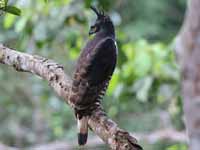


Eagle,_Changeable Hawk- Nisaetus cirrhatus
Description: The dark morph changeable hawk-eagle, also known as the crested hawk-eagle, has mostly brown plumage. It may have a large crest of about 4 feathers. The brown breast is white streaked. The light morph changeable hawk-eagle is similar but has a lightcolored head and whitish underparts. The dark and light morphs lead to their name: "changeable".
Range: Southeast Asia, including Malaysia, Indonesia, and the Phillipines.
Habitat: Evergreen forest.
Diet: Mammals, birds, reptiles. Hunts in the forest canopy.
Conservation status: Least Concern.
Image by: 1) MyLittleFinger- India 2) James Gordon - Sri Lanka 3) Kesara Rathnayake - Sri Lanka 4) Gaurika Wijeratne - Sri LankaRange: Southeast Asia, including Malaysia, Indonesia, and the Phillipines.
Habitat: Evergreen forest.
Diet: Mammals, birds, reptiles. Hunts in the forest canopy.
Conservation status: Least Concern.
1, 2) Dark morph 3, 4) Light morph

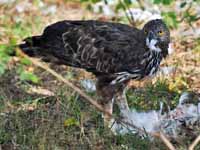
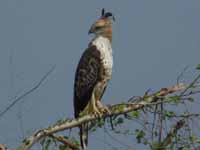

Eagle,_Flores_Hawk- Nisaetus floris
.Description: The Flores hawk-eagle has brown upperparts, white head with brown streaks on crest, white underparts, brown tail with 6 bars. There are white patches on the upperside of the primaries.
Range: Lesser Sundas of Indonesia.
Habitat: Forages over forests, especialy rainforests.
Diet: Mammals, birds, reptiles.
Conservation status: The Flores hawk-eagle is Critically Endangered because it has a small range and is killed because it takes chickens.
Image by: 1) Unknown 2) Abdul_Azis_GizanRange: Lesser Sundas of Indonesia.
Habitat: Forages over forests, especialy rainforests.
Diet: Mammals, birds, reptiles.
Conservation status: The Flores hawk-eagle is Critically Endangered because it has a small range and is killed because it takes chickens.
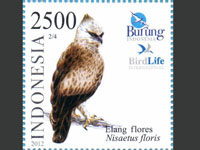
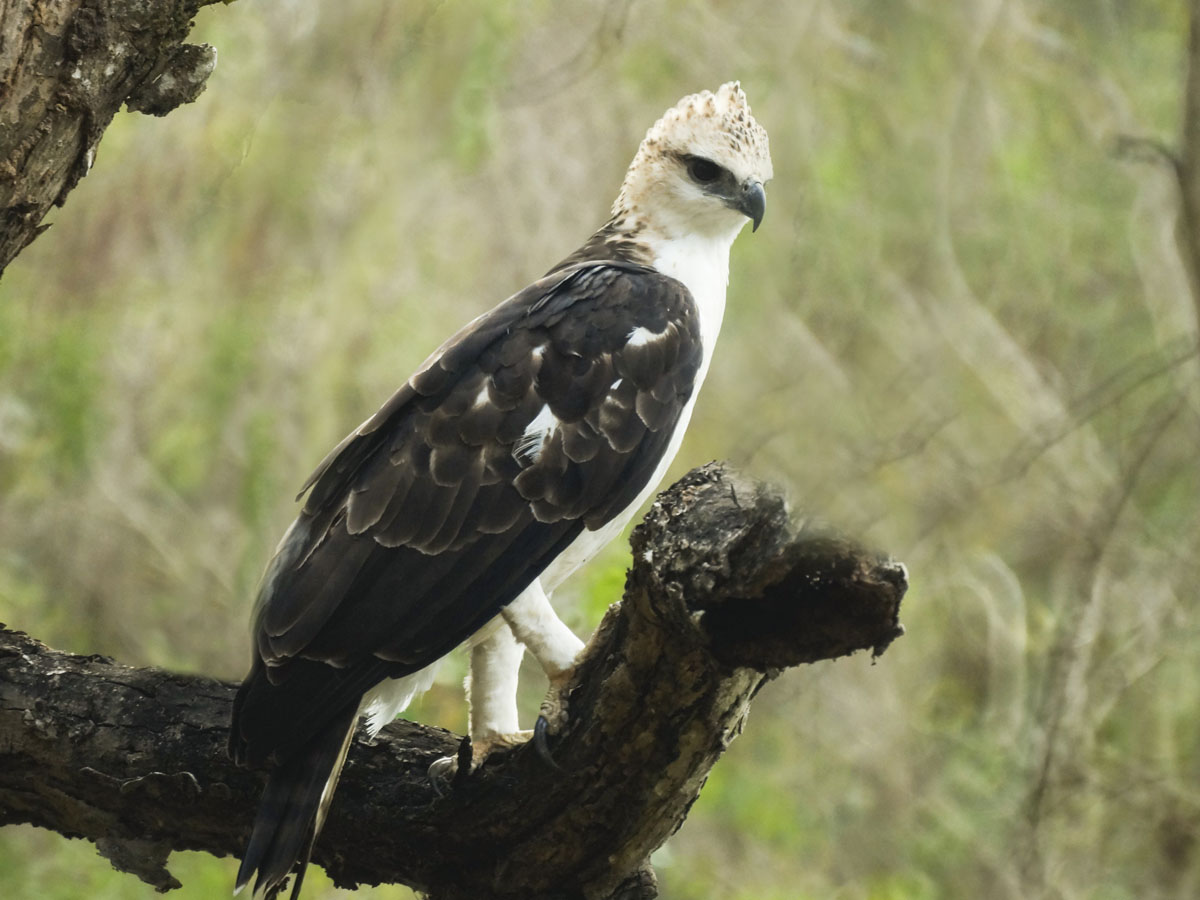
Eagle,_Javan Hawk- Nisaetus bartelsi
Description: The Javan hawk-eagle has dark brown upperparts, white underparts with rufous mottling, and an off-white throat with thin black stripes. It has a rufous head and neck. The light grey under-tail has 4 bars; the terminal bar is boldest. It has a long black crest and yellow eyes.
Range: East Java of Indonesia.
Habitat: Forest, but also treed open land.
Diet: Mainly mammals. Also birds, reptiles.
Conservation status: This species is so Endangered it is one of the rarest of raptors - less than 1,000 are left. The major factors for its decline are loss of habitat due to expanding population and selling of birds at markets.
Image by: 1) Midori - Bandung Zoo 2) Eko_Prastyo 3) Lip Kee - IndonesiaRange: East Java of Indonesia.
Habitat: Forest, but also treed open land.
Diet: Mainly mammals. Also birds, reptiles.
Conservation status: This species is so Endangered it is one of the rarest of raptors - less than 1,000 are left. The major factors for its decline are loss of habitat due to expanding population and selling of birds at markets.

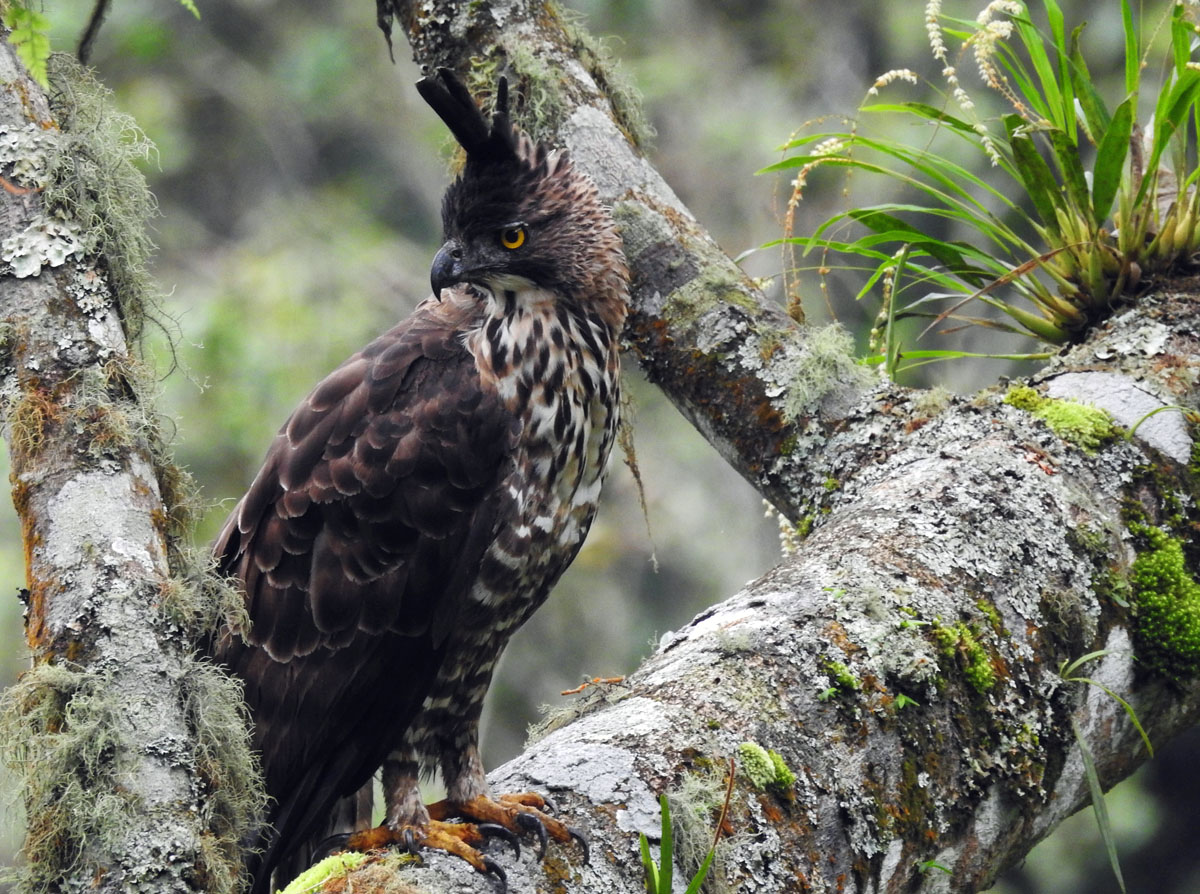
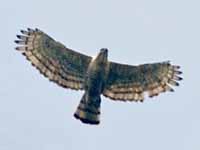
Eagle,_Legge's_Hawk- Nisaetus kelaarti
Description: The Legge's hawk-eagle is also considered a subspecies of the mountain hawk-eagle. It has brown upperparts, pale underparts with brown barring, and unlike Mountain hawk-eagle it has unstreaked buff under-wing coverts .
Range: Indian subcontinent, Sri Lanka.
Habitat: Forests, usually above 600 m. Large trees for nesting.
Diet: Mammals, birds, reptiles.
Conservation status: Least Concern.
Image by: 1) Yathin_Krishnappa Range: Indian subcontinent, Sri Lanka.
Habitat: Forests, usually above 600 m. Large trees for nesting.
Diet: Mammals, birds, reptiles.
Conservation status: Least Concern.

Eagle,_Mountain Hawk- Nisaetus nipalensis
Description: The mountain hawk-eagle has mottled dark brown upperparts and dark brown underparts with white barring. There are brown and white bars on the tail and the crown has tuffs of variable length.
Range: Southern Asia, Japan.
Habitat: Forests, usually above 600 m. Large trees for nesting
Diet: Mammals, birds, reptiles.
Conservation status: Least Concern.
Image by: 1) Ron Knight 2) Shrikant Rao - Bengal 3) Lip Kee Yap - Malaysia Range: Southern Asia, Japan.
Habitat: Forests, usually above 600 m. Large trees for nesting
Diet: Mammals, birds, reptiles.
Conservation status: Least Concern.
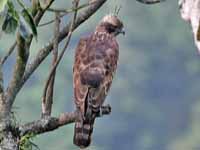
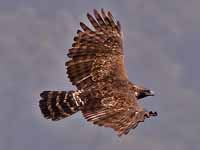
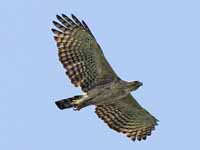
Eagle,_Philippine Hawk- Nisaetus philippensis
Description: The Phillippine hawk-eagle has brown upperparts, white breast with black streaks, rufous belly, grey tail with black bars, and yellow eyes. It may may have a large crest of about 4 feathers and the white throat may have a black streak.
Range: Philippines.
Habitat: Lowland forests.
Diet: Unknown.
Conservation status: It is endangered due to habit loss caused by deforestation for agriculture expansion and also logging.
Image by: 1) Chris Angelo Perez 2) David_QuitorianoRange: Philippines.
Habitat: Lowland forests.
Diet: Unknown.
Conservation status: It is endangered due to habit loss caused by deforestation for agriculture expansion and also logging.


Eagle,_Pinsker's_Hawk- Nisaetus pinskeri
Description: The Pinsker's hawk-eagle has dark greyish-brown upperparts with a a streaked brown and white head. The upper-breast is white with heavy dark stripes. The lower-breast and flanks are pale brown with dark stripes. The belly is barred.
Range: islands of Leyte, Samar, Negros and Mindanao in the Philippines.
Habitat: Mature forests.
Diet: Unknown.
Conservation status: The Pinsker's hawk-eagle is Endangered due to deforestation. The population is less than 1000.
No images in public domain.Range: islands of Leyte, Samar, Negros and Mindanao in the Philippines.
Habitat: Mature forests.
Diet: Unknown.
Conservation status: The Pinsker's hawk-eagle is Endangered due to deforestation. The population is less than 1000.
Eagle,_Sulawesi Hawk- Nisaetus lanceolatus
Description: The Sulawesi hawk-eagle has dark brown upperparts. It has a boldly-marked rufous-brown head and breast. The white belly has dark barring. The juvenile has dark brown upperparts; white head, underparts with some brown streaks / spots.
Range: Sulawesi, Indonesia and neighboring islands.
Habitat: Forest with open areas.
Diet: Mammals, birds, reptiles. Hunts over grassy areas; also hunts over the forest canopy.
Conservation status: Least Concern.
Image by: 1, 2) Lip Kee - IndonesiaRange: Sulawesi, Indonesia and neighboring islands.
Habitat: Forest with open areas.
Diet: Mammals, birds, reptiles. Hunts over grassy areas; also hunts over the forest canopy.
Conservation status: Least Concern.
1, 2) Juvenile

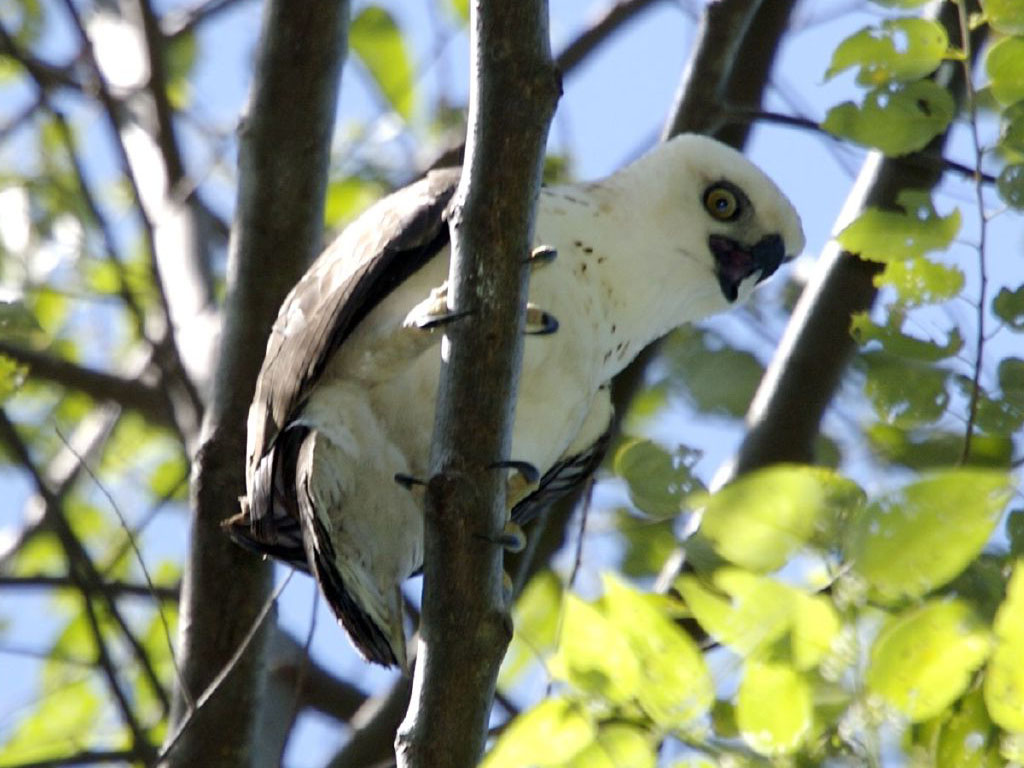
Eagle,_Wallace's Hawk- Nisaetus nanus
Description: The Wallace's hawk-eagle is one of the smallest eagles in the world, about the size of a peregrine falcon. It has dark brown upperparts, rufous-buff head with a black crest, and a whitish throat. It has yellowish-beige underparts with some dark streaking on the breast and dark bars on the belly. Up to 3 years, the sub-adult does not have streaks on the breast. The younger juvenile lacks streaks and bars on the underparts
Range: southeast Asia.
Habitat: Forest under 1000 m, elevation.
Diet: Birds, mammals, reptiles.
Conservation status: It is listed as Vulnerable due to reduction of lowland forest from agriculture expansion and logging.
Image by: 1) Mark Louis Benedict - Malaysia 2) Bernard_Dupont 3) Aqil_FRange: southeast Asia.
Habitat: Forest under 1000 m, elevation.
Diet: Birds, mammals, reptiles.
Conservation status: It is listed as Vulnerable due to reduction of lowland forest from agriculture expansion and logging.
2) Sub-adult 3) Juvenile
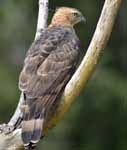
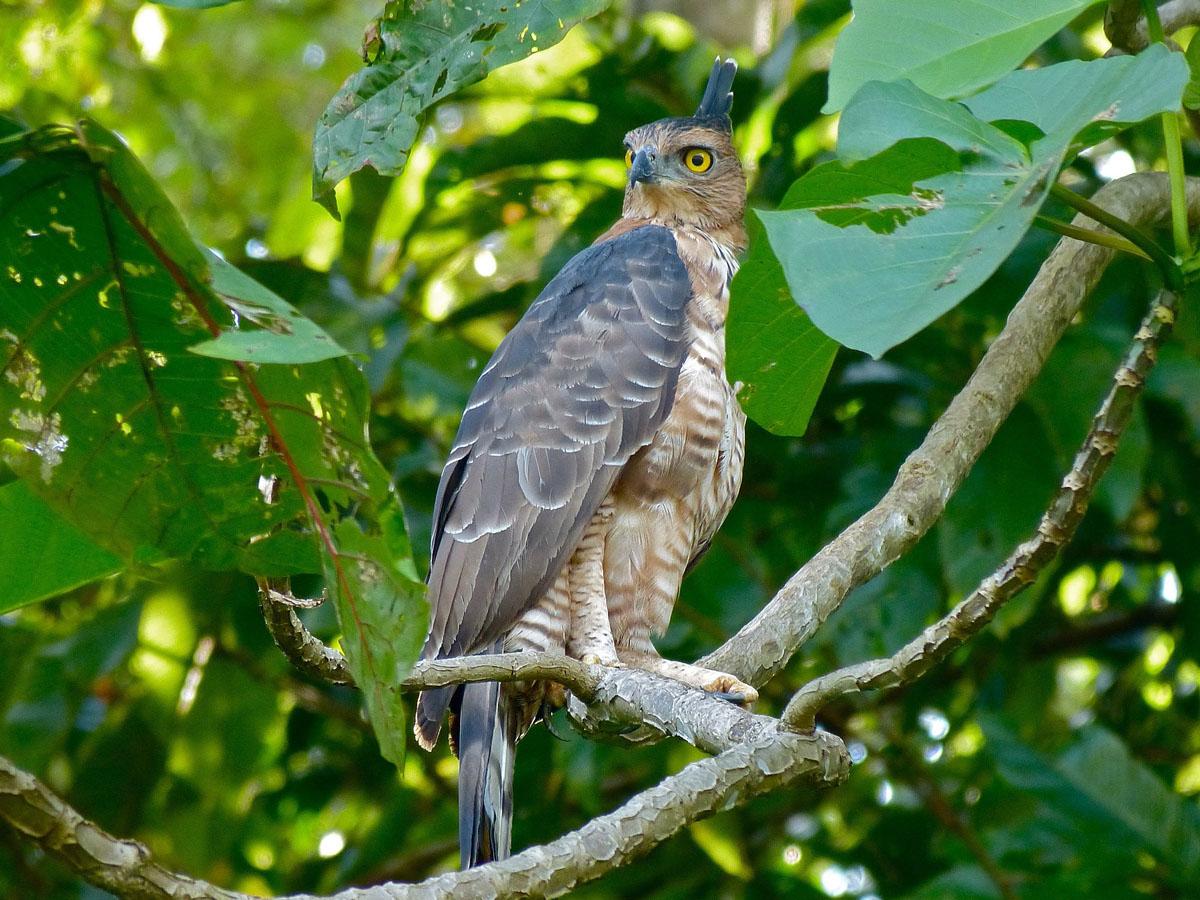
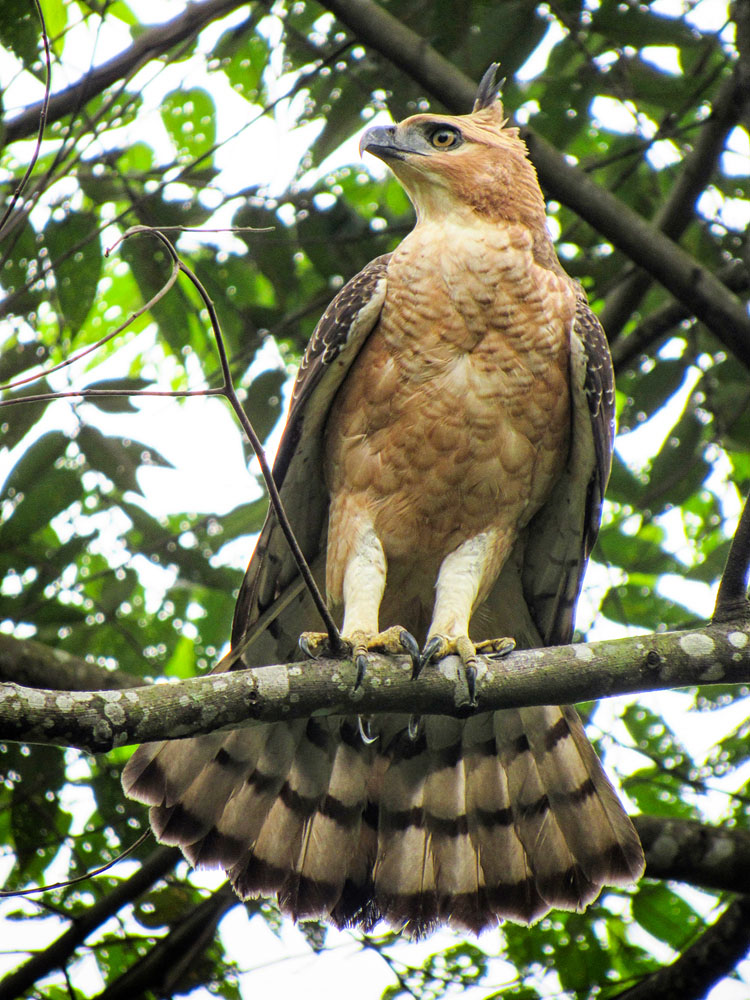
Genus Spizaetus
New World hawk-eagles. They are forest birds with several species having a preference for highland woodlands. They build stick nests in trees. The sexes are similarly plumaged with typical raptor brown upperparts and pale underparts, but young birds are distinguishable from adults, often by a whiter head. These hawk-eagles are in the Aquilinae (booted eagles) subfamily and thus have feathered legs.
Eagle,_Black Hawk- Spizaetus tyrannus
Description: The Black hawk-eagle has black plumage with some white speckling. The under-wings and tail are barred black-and-white. It has a black and white crest.
Range: Mexico, Central America, South America.
Habitat: Tropical lowland forests.
Diet: Mainly mammals; also birds and reptiles.
Conservation status: Least Concern.
Image by: 1) Tom Friedel (BirdPhotos.com) - Argentina 2) Nick Athanas - Columbia 3) Dave Wendelken - Panama Range: Mexico, Central America, South America.
Habitat: Tropical lowland forests.
Diet: Mainly mammals; also birds and reptiles.
Conservation status: Least Concern.
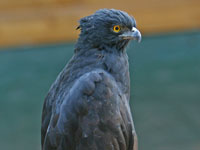
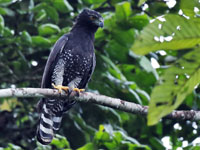

Eagle,_Black-and-white Hawk- Spizaetus melanoleucus
Description: The black-and-white hawk-eagle has black upperparts. The head, neck, and underparts are white. The black-and-white tail has a white tip. It has a yellow eye-ring surrounded by black. a black bill with yellow cere, yellow iris, and yellow feet.
Range: Mexico, Central America, South America.
Habitat: Mainly forests, but also scrubland.
Diet: Mainly birds; also mammals, reptiles.
Conservation status: Least Concern.
Image by: 1) Magalie L'Abbé 2) Mateus Hidalgo 3) Yusoff_AhmadRange: Mexico, Central America, South America.
Habitat: Mainly forests, but also scrubland.
Diet: Mainly birds; also mammals, reptiles.
Conservation status: Least Concern.
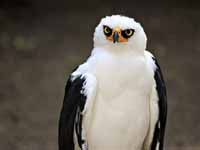
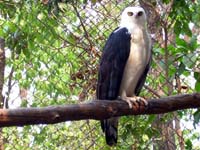

Eagle,_Black-and-chestnut Spizaetus isidori
Description: The black-and-chestnut eagle has black upperparts, head, and neck. It has a pointed crest. The underparts are chestnut with some fine black streaks. It has yellow eyes.
Range: The Andes of South America.
Habitat: Forested valleys of the Andes.
Diet: Birds, mammals. Soars over the canopy to seek prey.
Conservation status: This is Endangered due to removal of primary forests.
Range: The Andes of South America.
Habitat: Forested valleys of the Andes.
Diet: Birds, mammals. Soars over the canopy to seek prey.
Conservation status: This is Endangered due to removal of primary forests.
Image by: 1) Marc Athanase Parfait 2) Tom Friedel (BirdPhotos.com) 3) Arley_Vargas
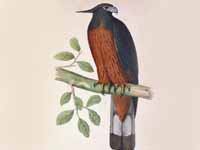
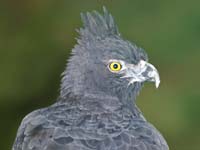
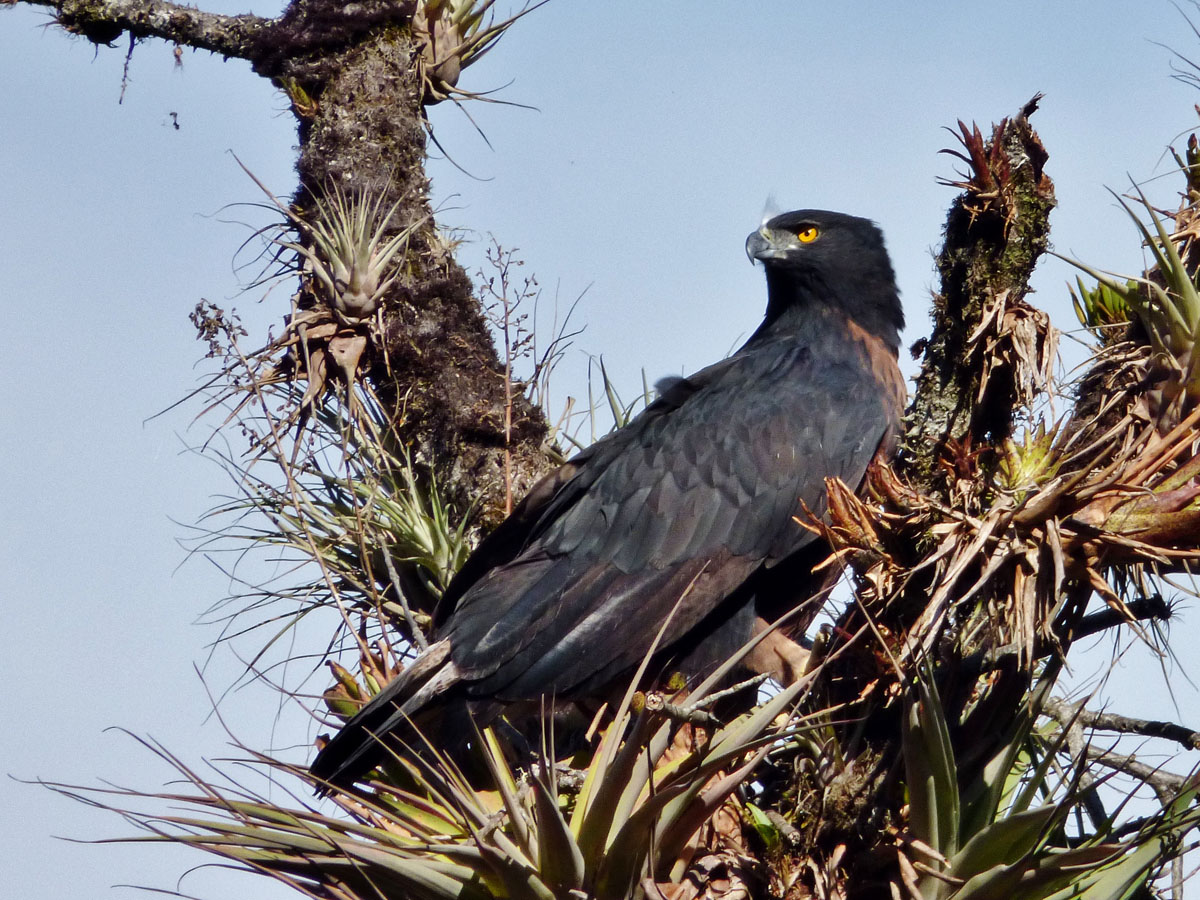
Eagle,_Ornate Hawk- Spizaetus ornatus
Description: The ornate eagle-hawk has blackish upperparts, crown, and crest. It has a chestnut nape and sides of the neck. The throat is white. The central-breast is white with a few chestnut streaks while the rest of the underparts are white with black barring. The under-tail is white with three dark bars and a white tip. The upper-wing coverts are black with white spots and the flight feathers are chestnut with dark barring. The juvenile has a white head, neck. and underparts.
Range: Mexico, Central America, South America .
Habitat: Forests, especially those with tall trees.
Diet: Mainly birds, also mammals, infrequently reptiles.
Conservation status: The ornate hawk is listed as Near Threatened as its population is declining and extinct from some areas. The major problem is deforestation.
Image by: 1) Mdf - Panama Juan 2) Nathan Rupert - San Diego Zoo 3) Mateus Hidalgo Range: Mexico, Central America, South America .
Habitat: Forests, especially those with tall trees.
Diet: Mainly birds, also mammals, infrequently reptiles.
Conservation status: The ornate hawk is listed as Near Threatened as its population is declining and extinct from some areas. The major problem is deforestation.
1) Juvenile
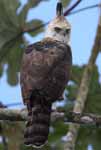
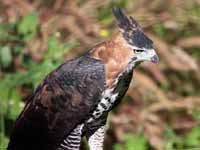

Genus Stephanoaetus - 1 species
Eagle,_Crowned Stephanoaetus coronatus
Description: The crowned hawk-eagle has blackish-grey plumage with the head being lighter in color. The blackish-grey underparts are definitive with bold white bars and and blotches. It is also known as the crowned hawk-eagle, but that is a misnomer becasue the hawk-eagle name usually implies a small eagle, but this one can weigh over 4 kg.
Range: Sub-Saharan Africa.
Habitat: Forests, prefers thick forests.
Diet: Mainly mammals; also birds, reptiles. A very powerful eagle, it will take monkeys weighing more than itself.
Conservation status: The crowned eagle is Near Threatened because of vast destruction of the African tropical forest.
Image by: 1) Steve Garvie - Kenya 2) Bernard_Dupont - South Africa 3) Derek_Keats - Soth AfricaRange: Sub-Saharan Africa.
Habitat: Forests, prefers thick forests.
Diet: Mainly mammals; also birds, reptiles. A very powerful eagle, it will take monkeys weighing more than itself.
Conservation status: The crowned eagle is Near Threatened because of vast destruction of the African tropical forest.
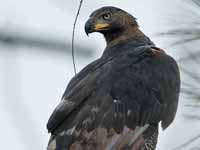


Circaetinae – serpent eagles
The serpent eagles mainly specialize in eating snakes, lizards, and other reptiles. Some of this subfamily are just as likely to eat small mammals and birds, but they are the exception. The mostly live in temperate or tropical regions of the Old World. Serpent-eagles build stick nests and lay just one egg. They are found in Eurasia and Africa, not in the New World.
Genus Circaetus
The Snake-eagles eat mainly snakes but also lizards and small mammals. Their excellent eyesight enables them to spot their prey at a distance. They are medium sized eagles. Unlike the booted eagles, their lower legs are not feathered. They are found exclusively in Africa, except for the short-toed snake-eagle which is also found in a limited part of Europe and Asia.
Eagle,_Black-chested Snake- Circaetus pectoralis
Description: The black-chested snake-eagle has dark brown upperparts, head, and upper-breast. The lower-breast and belly are white. It has yellow eyes.
Range: southern Africa.
Habitat: Open spaces such as grasslands. Avoids forests.
Diet: Mainly snakes; also lizards, small mammals and frogs.
Conservation status: Least Concern.
Image by: 1) Gaurav Pandit - Tanzania 2) Arno Meintjes 3) Nik_BorrowRange: southern Africa.
Habitat: Open spaces such as grasslands. Avoids forests.
Diet: Mainly snakes; also lizards, small mammals and frogs.
Conservation status: Least Concern.
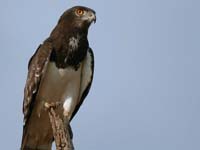
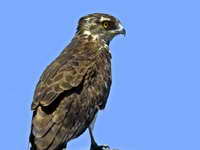
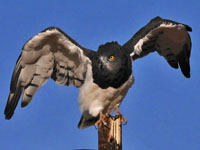
Eagle,_Beaudouin's Snake- Circaetus beaudouini
Description: The Beaudouin's snake-eagle has greyish-brown upperparts and a dark bib with some white. The lower-breast and belly are white with dark barring.
Range: Central Africa.
Habitat: Open woodlands, wooded savanna and cultivated areas.
Diet: Mainly snakes; also lizards, small mammals and frogs.
Conservation status: This eagle is Vulnerable due to poisons, hunting, urbanization.
Image by: 1, 3) Steve Garvie - Gambia 2) David Cook - UgandaRange: Central Africa.
Habitat: Open woodlands, wooded savanna and cultivated areas.
Diet: Mainly snakes; also lizards, small mammals and frogs.
Conservation status: This eagle is Vulnerable due to poisons, hunting, urbanization.

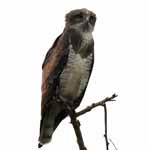
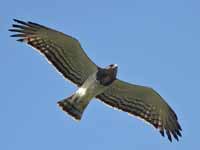
Eagle,_Brown Snake- Circaetus cinereus
Description: The Brown Snake-Eagle has brown plumage, yellow eyes, and black bill. The under-wings are white except for the coverts. It is the largest member of its genus, weighing up to 2.5 kg.
Range: Sub-Saharan Africa.
Habitat: Open woodlands and savannas.
Diet: Mainly snakes; also lizards, small mammals, birds.
Conservation status: Least Concern.
Image by: 1) Aviceda - Murchison Falls NP, Uganda 2) Arno Meintjes 3) Nik_Borrow - Tanzania 4) Bernard_Dupont. - South AfricaRange: Sub-Saharan Africa.
Habitat: Open woodlands and savannas.
Diet: Mainly snakes; also lizards, small mammals, birds.
Conservation status: Least Concern.
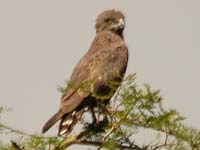

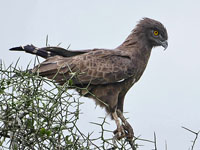
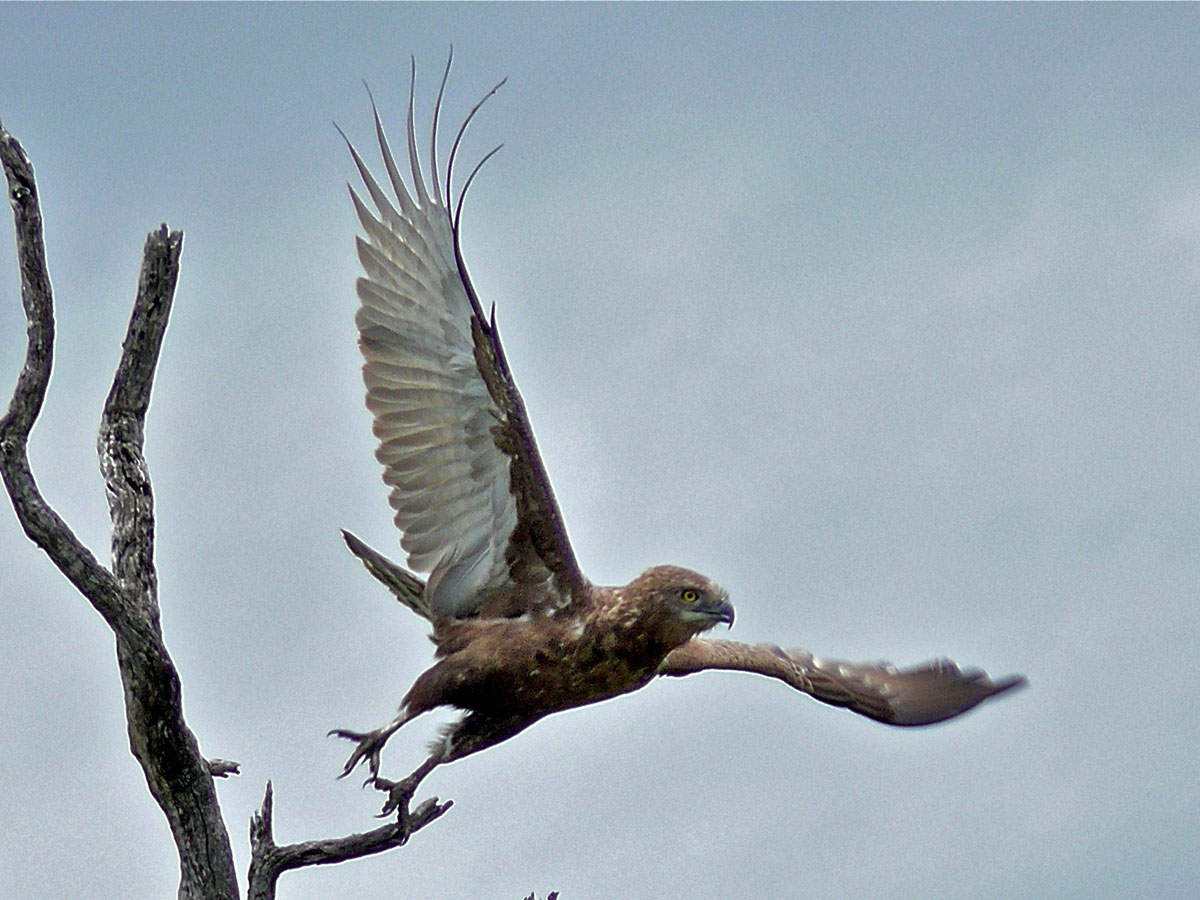
Eagle,_Short-toed Snake- Circaetus gallicus
Description: The short-toed snake-eagle, also known as the short-toed eagle, has greyish-brown upperparts, off-white head, and white underparts with speckles / streaks. The under-wings are off-white with light barring. It has a owl shaped head.
Range: Europe (especially Spain), Asia , Africa (central) .
Habitat: Requires trees for nesting and open habitats, such as cultivations and grasslands for foraging.
Diet: Mainly snakes, also lizards. Occasionally small mammals.
Conservation status: Least Concern.
Image by: 1) Orchi 2) Mario M 3) JV Verde - PortugalRange: Europe (especially Spain), Asia , Africa (central) .
Habitat: Requires trees for nesting and open habitats, such as cultivations and grasslands for foraging.
Diet: Mainly snakes, also lizards. Occasionally small mammals.
Conservation status: Least Concern.



Eagle,_Southern Banded Snake- Circaetus fasciolatus
Description: The southern banded snake-eagle, also known as the fasciated snake-eagle, has grey-brown upperparts, with paler grey-brown head and bib. It has a whitish lower-breast and belly with barring, yellow eyes and yellow feet.
Range: Africa (along the east coast from Somalia to Zimbabwe).
Habitat: Coastal evergreen forests or forests close to wetlands.
Diet: Mainly snakes and lizards. Also mammals and birds.
Conservation status: The southern banded snake-eagle is listed as Near Threatened because of declining population due to habitat loss.
Image by: 1) Peter_Steward - Malawi 2 Nick Athanas - KenyaRange: Africa (along the east coast from Somalia to Zimbabwe).
Habitat: Coastal evergreen forests or forests close to wetlands.
Diet: Mainly snakes and lizards. Also mammals and birds.
Conservation status: The southern banded snake-eagle is listed as Near Threatened because of declining population due to habitat loss.
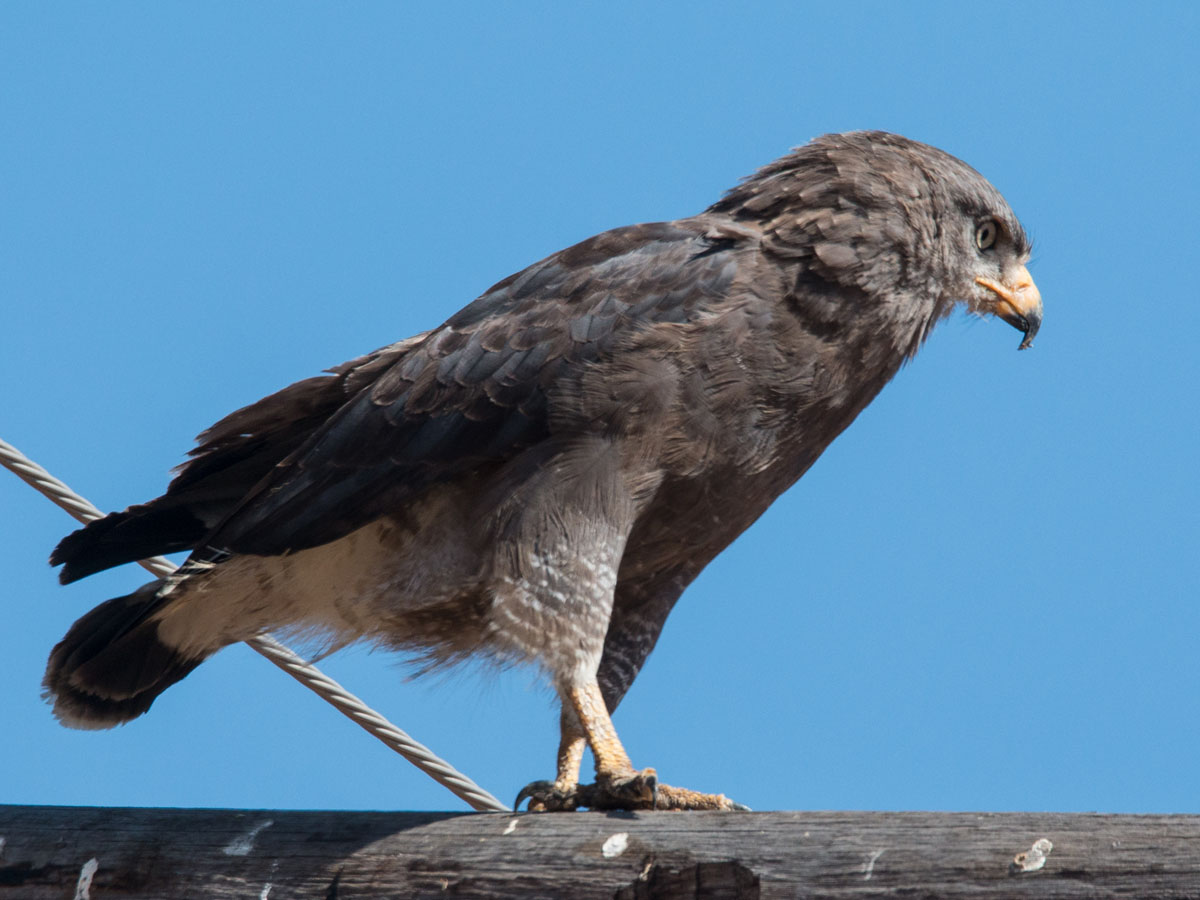
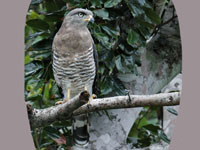
Eagle,_Western Banded Snake- Circaetus cinerascens
Description: The western banded snake-eagle, also known as the banded snake-eagle, has grey-brown plumage; yellow eyes, and yellow legs. The under-tail is half white and half with a big black band which has a white tip.
Range: Africa (Central Africa and south).
Habitat: Forest, but not rainforest. Also cultivated areas.
Diet: Snakes, lizards, turtles.
Conservation status: Least Concern.
Image by: 1) Nik_Borrow - Uganda 2) Bernard_Dupont - Uganda 3) Nik_Borrow - Zambia 4) Ron Knight Range: Africa (Central Africa and south).
Habitat: Forest, but not rainforest. Also cultivated areas.
Diet: Snakes, lizards, turtles.
Conservation status: Least Concern.

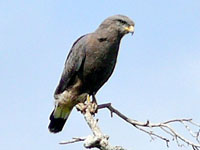
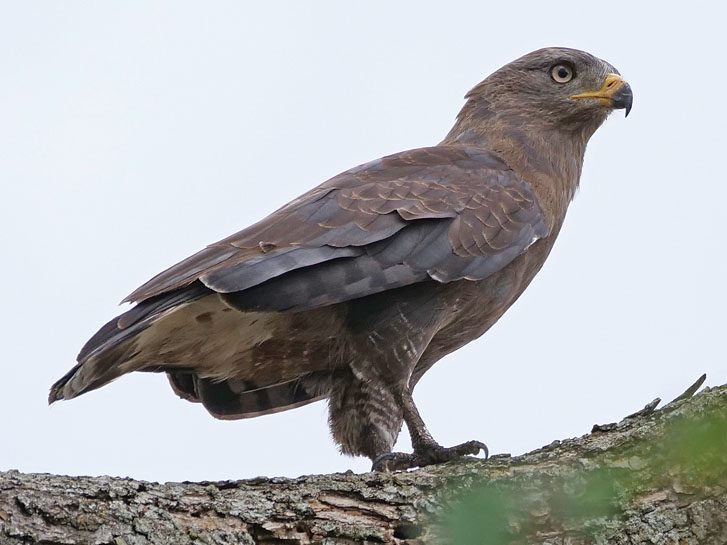
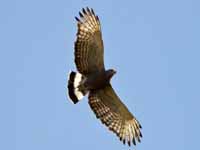
Genus Dryotriorchis - 1 species
For other serpent-eagles, see Spilornis and Eutriorchis.
Eagle,_Congo-Serpent Dryotriorchis spectabilis Found:
Description: The congo serpent eagle has brown upperparts and white underparts. A subspecies (D. s. spectabilis) has black spots on the underparts and another (D. s. batesis) has black spots on the flanks. It has short rounded wings and a long rounded tail. The light brown tail has 5 or 6 dark bars. The female has dark eyes, while the male has yellow eyes.
Range: Western and Central Africa.
Habitat: Dense forest.
Diet: Snakes, lizards, frogs; also mammals.
Conservation status: Least Concern.
Image by: 1, 2, 3) Nik_Borrow - Gabon, GhanaRange: Western and Central Africa.
Habitat: Dense forest.
Diet: Snakes, lizards, frogs; also mammals.
Conservation status: Least Concern.
1, 2) Female 3) Male
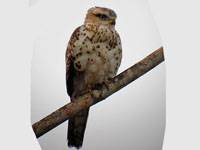
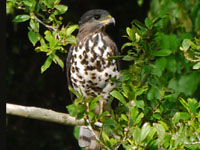

Genus Pithecophaga - 1 species
Eagle,_Philippine Pithecophaga jefferyi Found:
Description: The Philippine eagle has brown upperparts and white underparts. It has long neck feathers and a light brown tail which has a darker subterminal band and white tip. Weighing up to 8 kg, it is one of the largest eagles and most powerful.
Range: The Philippines.
Habitat: Forests.
Diet: Mammals, snakes.
Conservation status: The Philippine eagle is Critically Endangered due to deforestation through logging and expanding agriculture.
Image by: 1) Voltaire Malazarte 2) Harrybalais - The Philippine Eagle Center
3) scorpious18Range: The Philippines.
Habitat: Forests.
Diet: Mammals, snakes.
Conservation status: The Philippine eagle is Critically Endangered due to deforestation through logging and expanding agriculture.


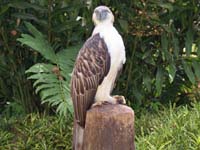
Genus Spilornis
The Asian serpent-eagles have a dark crown, bright yellow eyes and cere (waxy covering at base of bill). Other speices termed serpent-eagles are Congo Serpent-Eagle and Madagascar Serpent-Eagle.
Eagle,_Andaman Serpent- Spilornis elgini Found: India
Description: The Andaman serpent-eagle has mainly dark brown plumage. The underparts, including the under-wings, have small white spots. The dark brown tail has one white band. It has a yellow face, bill, lores, and legs.
Range: Andaman Islands in southeast India.
Habitat: Forests where the trees are not dense, for example, in clearings.
Diet: Snakes, lizards, birds.
Conservation status: Listed as Vulnerable because it has a small range and small population.
Image by: 1) Balaji Venkatesh Sivaramakrishnan 2) TR_Shankar_RamanRange: Andaman Islands in southeast India.
Habitat: Forests where the trees are not dense, for example, in clearings.
Diet: Snakes, lizards, birds.
Conservation status: Listed as Vulnerable because it has a small range and small population.
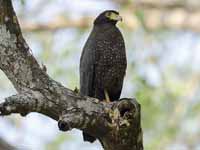

Eagle,_Crested Serpent- Spilornis cheela
Description: The crested serpent-eagle has dark brown upperparts, lighter brown underparts, and yellow facial skin. There are numerous subspecies of varying appearance. Some have small white spots on the underparts. The tail may have one or two white bands. The juvenile has white underparts and head.
Range: Tropical Asia.
Habitat: Variety of tropical and subtropical forests. The forest should not be dense.
Diet: Mainly snakes. Also birds, amphibians.
Conservation status: Least Concern
Image by: 1) Sasidharanmanekkara 2) J
M Garg - India 3) Andy_LiRange: Tropical Asia.
Habitat: Variety of tropical and subtropical forests. The forest should not be dense.
Diet: Mainly snakes. Also birds, amphibians.
Conservation status: Least Concern
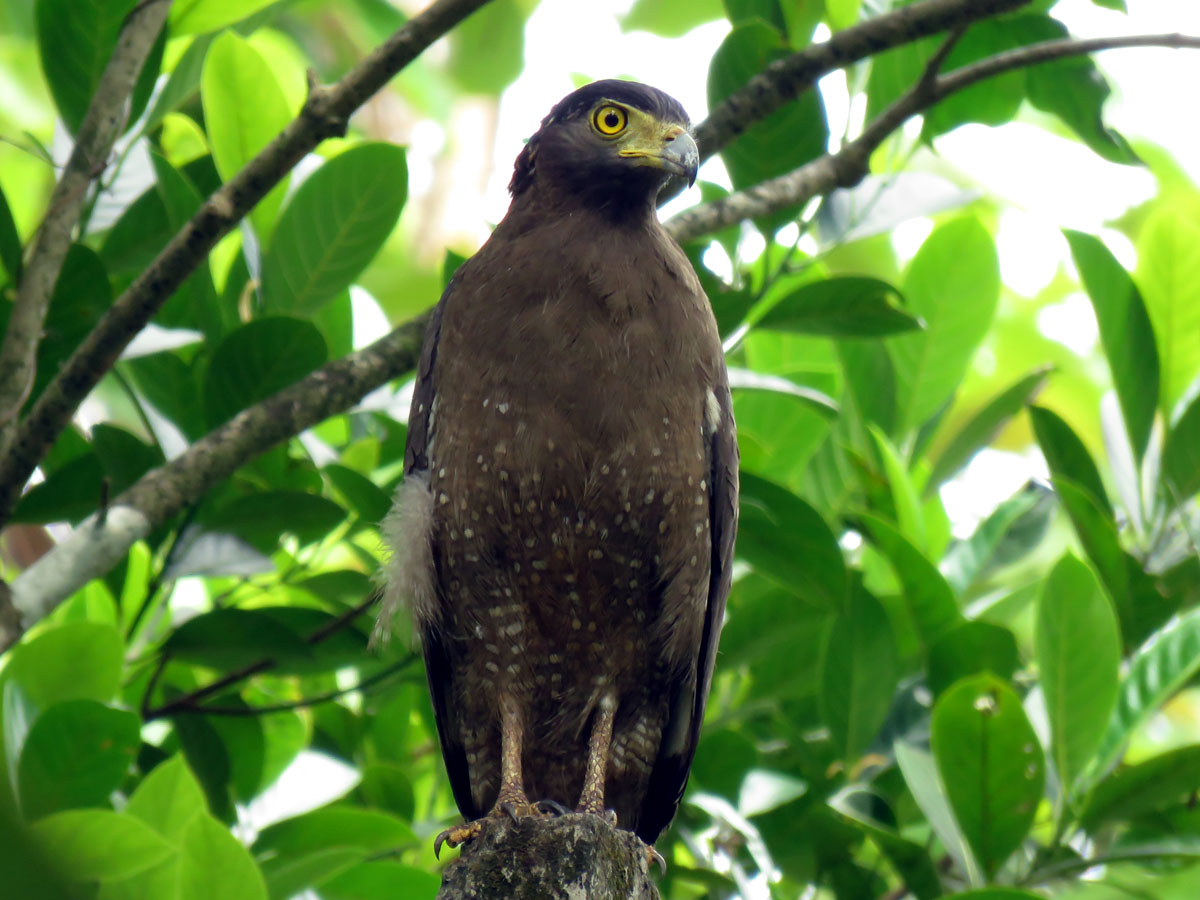

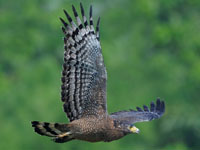
Eagle,_Mountain_Serpent- Spilornis kinabaluensis
Description: The mountain serpent-eagle has dark upperparts and yellowish-brown underparts. It has yellow facial skin. The under-wing covers are black and across the flight feathers there is a bold white band. The under-tail is black with a white band in the middle. The underparts are darker than the Bornean subspecies of the crested_serpent-eagle.
Range: Borneo.
Habitat: Forests above 750 m.
Diet: Mainly snakes. Also birds, amphibians.
Conservation status: The mountain serpent-eagle is listed as Vulnerable due to habit loss. However they also occupy parks that are protected by the government plus the terrain makes logging difficult; therefore the hope is that populations may stabilize.
No public domain images available.Range: Borneo.
Habitat: Forests above 750 m.
Diet: Mainly snakes. Also birds, amphibians.
Conservation status: The mountain serpent-eagle is listed as Vulnerable due to habit loss. However they also occupy parks that are protected by the government plus the terrain makes logging difficult; therefore the hope is that populations may stabilize.
Eagle,_Nicobar_Serpent- Spilornis klossi
Description: The Nicobar serpent-eagle is the smallest eagle with a weight under 500 kg. It has a black crown, yellow facial skin, dark upperparts, pale unbarred underparts, and a short tail with thin dark bars.
Range: Great Nicobar island of India.
Habitat: Mainly in low forests, but also in open areas.
Diet: Lizards, small birds.
Conservation status: It is considered Near Threatened because of its limited range. Population thought to be in decline.
Image by: 1) Shreeram_MV Range: Great Nicobar island of India.
Habitat: Mainly in low forests, but also in open areas.
Diet: Lizards, small birds.
Conservation status: It is considered Near Threatened because of its limited range. Population thought to be in decline.

Eagle,_Philippine Serpent- Spilornis holospilus
Description: The Philippine serpent-eagle has brown upperparts, a black crown, and rufous underparts with white spots mainly on the breast. It has a greyish-brown throat and cheeks The tail is black with a white central band. It has yellow facial skin and legs. There is a black eye-ring.
Range: Philippine Islands.
Habitat: Forests. Often seen soaring over clearings and river valleys.
Diet: Snakes. Diet not well known.
Conservation status: Least Concern.
Image by: 1) Charles Laigo 2) Lip Kee 3) Ranieljosecastaneda 4) Mark A Harper Range: Philippine Islands.
Habitat: Forests. Often seen soaring over clearings and river valleys.
Diet: Snakes. Diet not well known.
Conservation status: Least Concern.
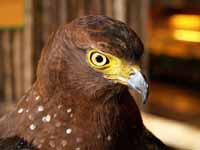
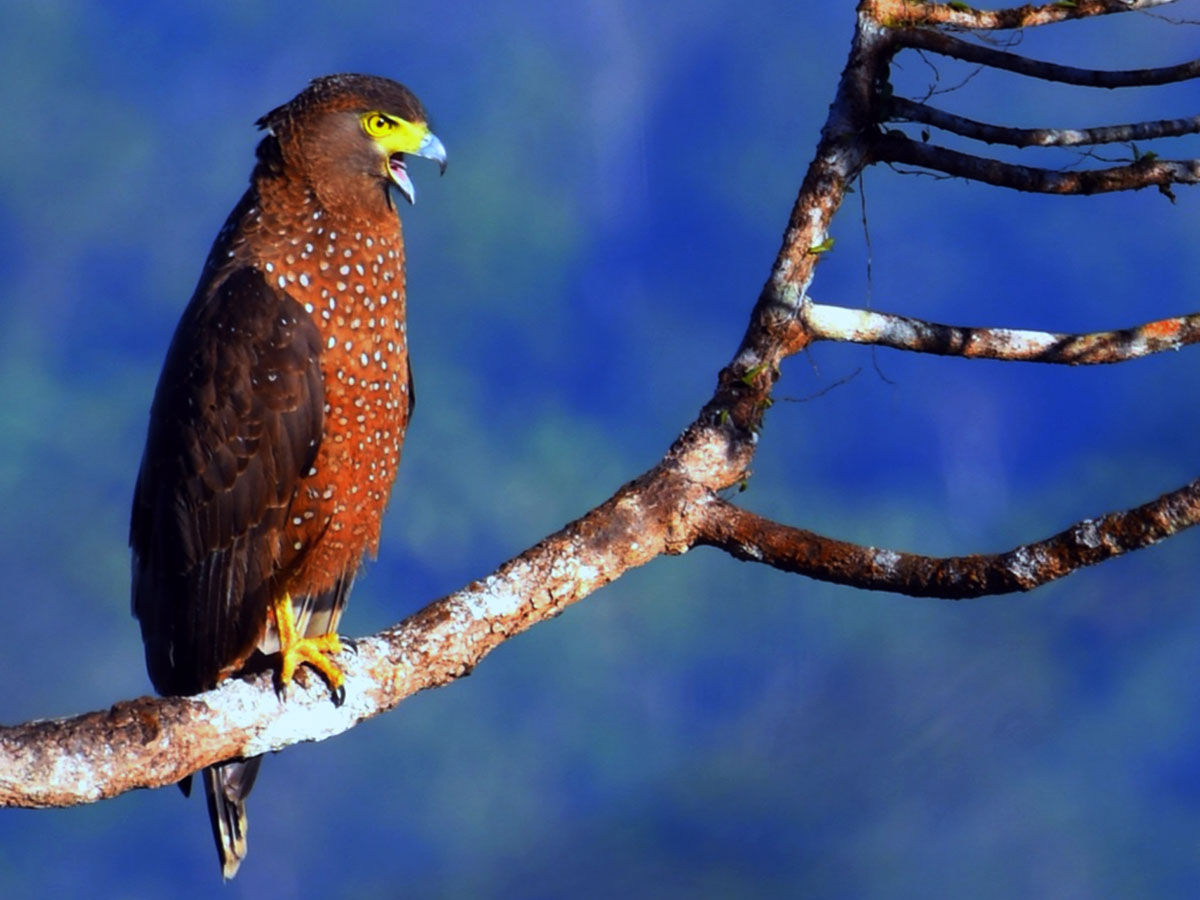

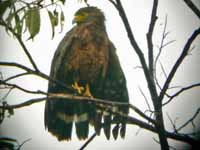
Eagle, Sulawesi Serpent- Spilornis rufipectus
Description: The Sulawesi serpent-eagle has dark brown upperparts, dark grey cheeks, and a rufous breast. The belly is light with dark barring. The eyes, facial skin, and legs are yellow.
Range: Sulawesi in Indonesia.
Habitat: Open areas such as forest edges, clearings, gardens.
Diet: Sankes, lizards, small mammals.
Conservation status: Least Concern.
Image by: 1) Joseph Wolf 2) Peter_WiltonRange: Sulawesi in Indonesia.
Habitat: Open areas such as forest edges, clearings, gardens.
Diet: Sankes, lizards, small mammals.
Conservation status: Least Concern.
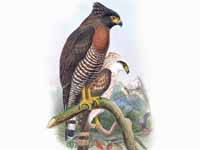

Genus Terathopius - 1 species
Bateleur Terathopius ecaudatus
Description: The bateleur has a black head, neck, and underparts. It has brown to chestnut mantle, rump, and tail. The facial skin, eyes, and legs are reddish. The male has under-wings with black secondaries, while for the female they are white with black tips.
Range: Sub-Saharan Africa.
Habitat: Open woodland and treed savanna.
Diet: Mammals, carrion. Also birds, snakes.
Conservation status: The bateleus is listed as Endangered. Populations are decreasing because their feathers are used by "traditional healer" to predict the future. An even bigger challenge is the use of poison that they ingest while eating carrion.
Image by: 1) Nathan Rupert 2, 3, 4) Nik_Borrow 5) Arno Meintjes 6) Tony Hisgett Range: Sub-Saharan Africa.
Habitat: Open woodland and treed savanna.
Diet: Mammals, carrion. Also birds, snakes.
Conservation status: The bateleus is listed as Endangered. Populations are decreasing because their feathers are used by "traditional healer" to predict the future. An even bigger challenge is the use of poison that they ingest while eating carrion.
2, 3) Male 4 -6 Female

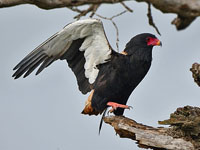
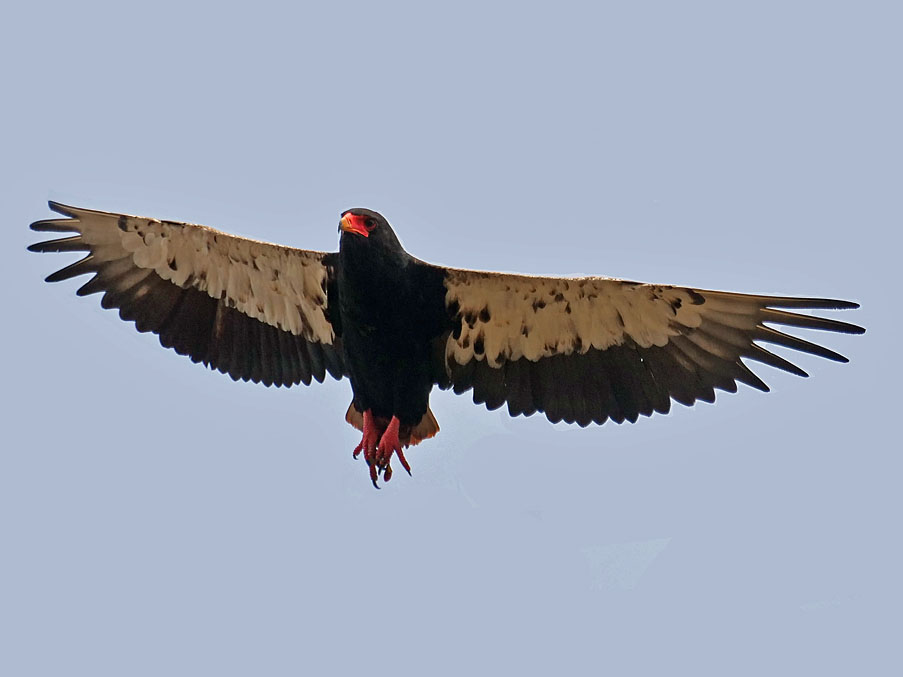

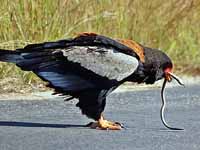

Harpiinae – forest eagles
There are only four species in this forest eagle subfamily. They are found mainly in tropical forests. They are named after the mythological greek monsters, half human and half bird, that carry people to the underworld. Their size varies greatly from the bat hawk of under 650 g. to the harpy eagle which can weigh more than 7 kg.
Genus Harpia - 1 species
Eagle,_Harpy Harpia harpyja
Description: The harpy eagle has slate-black upperparts and upper-breast. The grey head has a crest. It has a white lower-breast and belly. The bill is black. The harpy eagle is the largest eagle in the Americas. The males weights up to 6000 grams and the female to 10 kg. The smaller but similar black-chested buzzard-eagle has a yellow bill while the harpy eagle has blackish bill.
Range: Mexico, Central America, South America.
Habitat: Tropical evergreen forest that may have open areas.
Diet: Medium-sized mammals. Also, birds and reptiles.
Conservation status: The harpy eagle is listed as Near Threatened. The population is declining because of habitat destruction via logging, agriculture, and prospecting. Hunting is also a major challenge.
Image by: 1) Alan_Hopkins 2) Tom Friedel (BirdPhotos.com) 3) Nick Athanas - Brazil 4) Jitze_CouperusRange: Mexico, Central America, South America.
Habitat: Tropical evergreen forest that may have open areas.
Diet: Medium-sized mammals. Also, birds and reptiles.
Conservation status: The harpy eagle is listed as Near Threatened. The population is declining because of habitat destruction via logging, agriculture, and prospecting. Hunting is also a major challenge.
1) Juvenile
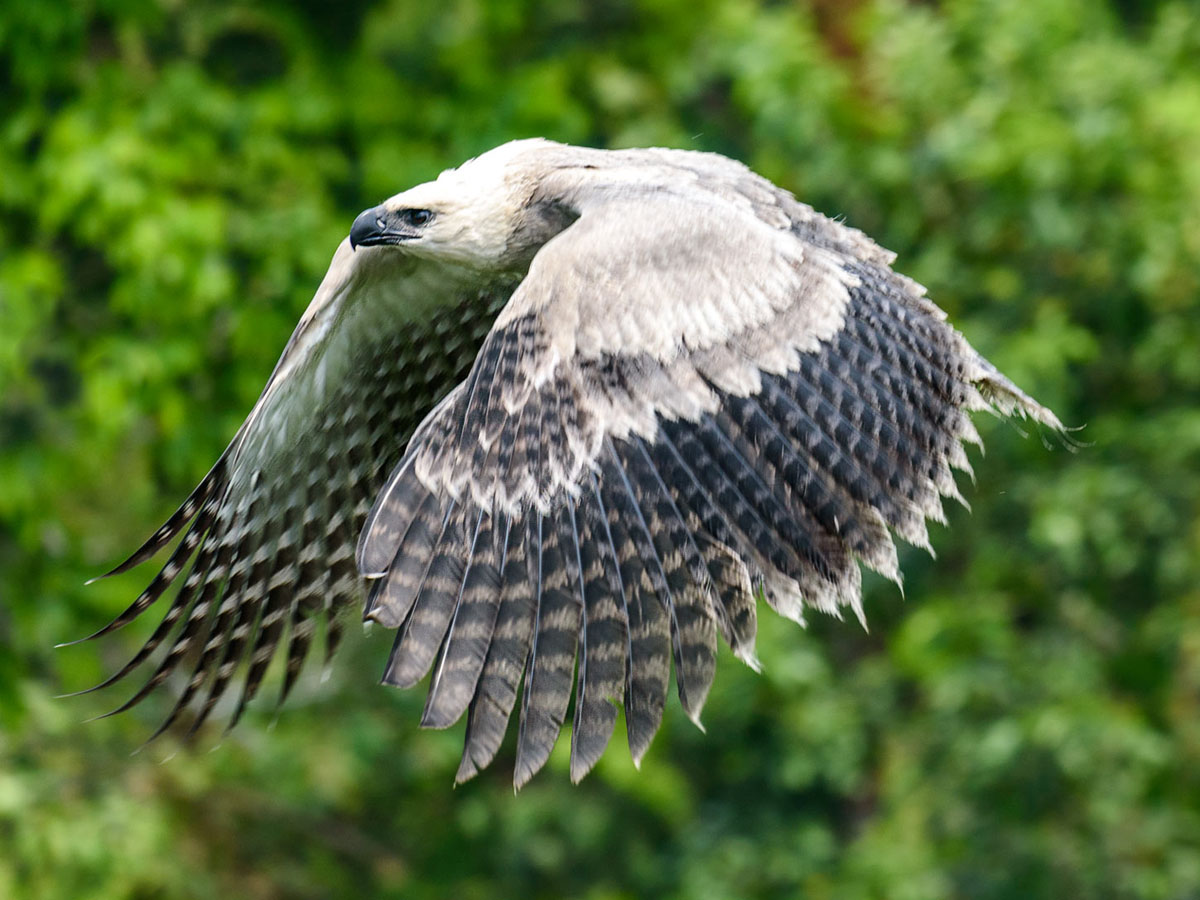
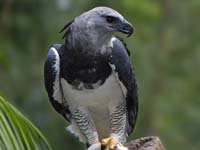
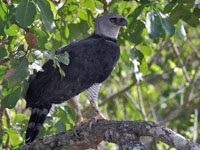

Genus Harpyopsis - 1 species
Eagle,_New Guinea Harpyopsis novaeguineae
Description: The New Guinea eagle, also known as the Papuan eagle, has grey upperparts andwhitish underparts. It has a very long black tail with a white tip.
Range: New Guinea.
Habitat: Mainly undisturbed forest. Also, clearing and gardens.
Diet: Medium-sized mammals. Also, birds and reptiles.
Conservation status: The New Guinea eagle is listed as Vulnerable as the population is declining rapidly due to deforestation.
Image by: 1) Markaharper 2) gailhampshireRange: New Guinea.
Habitat: Mainly undisturbed forest. Also, clearing and gardens.
Diet: Medium-sized mammals. Also, birds and reptiles.
Conservation status: The New Guinea eagle is listed as Vulnerable as the population is declining rapidly due to deforestation.
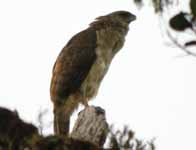

Genus Macheiramphus - 1 species
Even though this species is called the bat hawk, it is currently placed in eagle subfamily Harpiinae. It used to be classified with the small kite subfamily elanine which have long slender wings, while the bat hawk has relatively broad wings. However, the bat hawk's small size of under 650 g. also seems to be a misfit with the much larger forest eagles. It will probably be reclassified yet again.
Hawk,_Bat Macheiramphus alcinus
Description: The Bat Hawk has mainly dark brown or black plumage. It has a white throat with black median line. It has the smallest bill of any species listed in the eagle subfamilies.
Range: Mainly Africa, also Southeast Asia.
Habitat: Forests. Also savanna if bats are present.
Diet: Mainly bats; also birds, large insects. Likes to hunt on a moonlit night.
Conservation status: Least Concern.
Image by: 1) Johan van Rensburg 2) Gary AlbertRange: Mainly Africa, also Southeast Asia.
Habitat: Forests. Also savanna if bats are present.
Diet: Mainly bats; also birds, large insects. Likes to hunt on a moonlit night.
Conservation status: Least Concern.
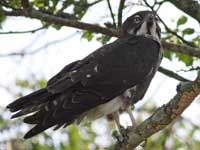
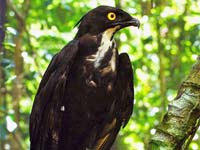
Genus Morphnus - 1 species
Eagle,_Crested Morphnus guianensis
Description: The crested eagle has different color morphs. Most have light brownish-grey upperparts, a white throat, small dark mask, and pale underparts. Dark morphs may have sooty-grey or almost black upperparts. All have a dark colored bill. It is a large and powerful eagle, weighing up to 3 kg.
Range: Central America, South America.
Habitat: Humid lowland forests, mostly comprised by tropical rainforests.
Diet: Snakes and mammals taken in trees or on the ground.
Conservation status: Near Threatened due to habitat loss.
Image by: 1) Yannick_TURBE 2) Alex_Lee 3) jacksnipe1990Range: Central America, South America.
Habitat: Humid lowland forests, mostly comprised by tropical rainforests.
Diet: Snakes and mammals taken in trees or on the ground.
Conservation status: Near Threatened due to habitat loss.
1) Dark morph

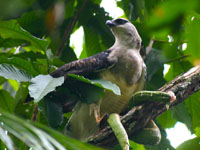
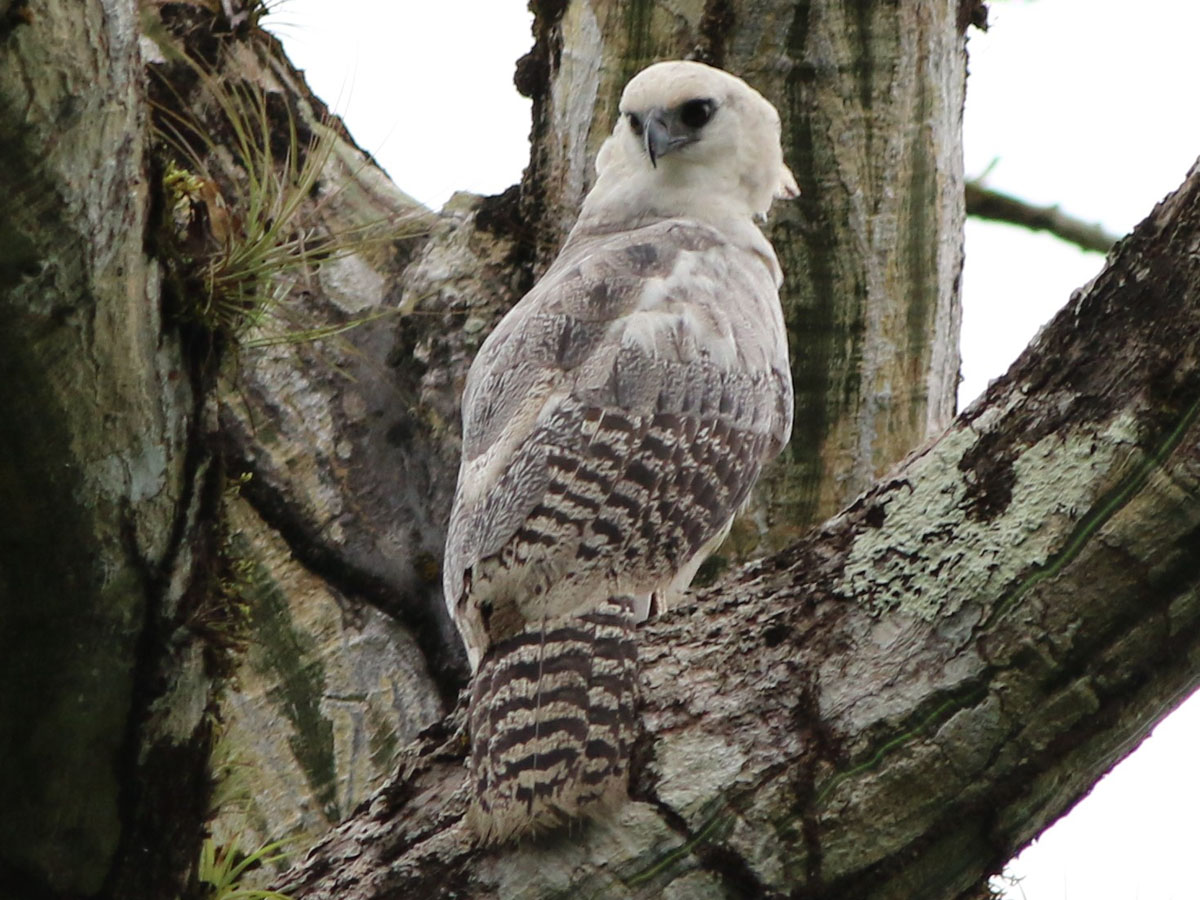
Fish Eagles and Sea-Eagles
The fish eagels have structures on its toes called spiricules that allow it to grasp fish and other slippery prey. Many of the fish eagles have almost as much feathering on their legs as do the booted eagles. The fish eagles are probably closer to kites of genus Milvus which has been placed in the hawk subfamily Buteoninae. Instead of placing them with the hawks, they are placed here with the eagles to save confusion.
Genus Haliaeetus
Fish eagles, also know as sea eagles, eat mainly fish and small mammals. Most have white tails.
Eagle,_African Fish- Haliaeetus vocifer
Description: The African fish-eagle has brown upperparts with black wings. The head, nape, and upper-breast are white. It has a brown belly and a blackish bill with yellow cere.
Range: Sub-Saharan Africa.
Habitat: Near freshwater lakes, reservoirs, and rivers; occasionally near the coast.
Diet: Mainly fish which it usually spots from a perch in a tree.
Conservation status: Least Concern.
Image by: 1, 4)
AngMoKio 2) Charles_Sharp - Ethiopia 3) Dick Daniels - Tanzania Range: Sub-Saharan Africa.
Habitat: Near freshwater lakes, reservoirs, and rivers; occasionally near the coast.
Diet: Mainly fish which it usually spots from a perch in a tree.
Conservation status: Least Concern.
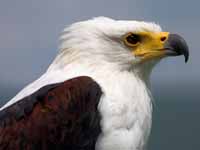
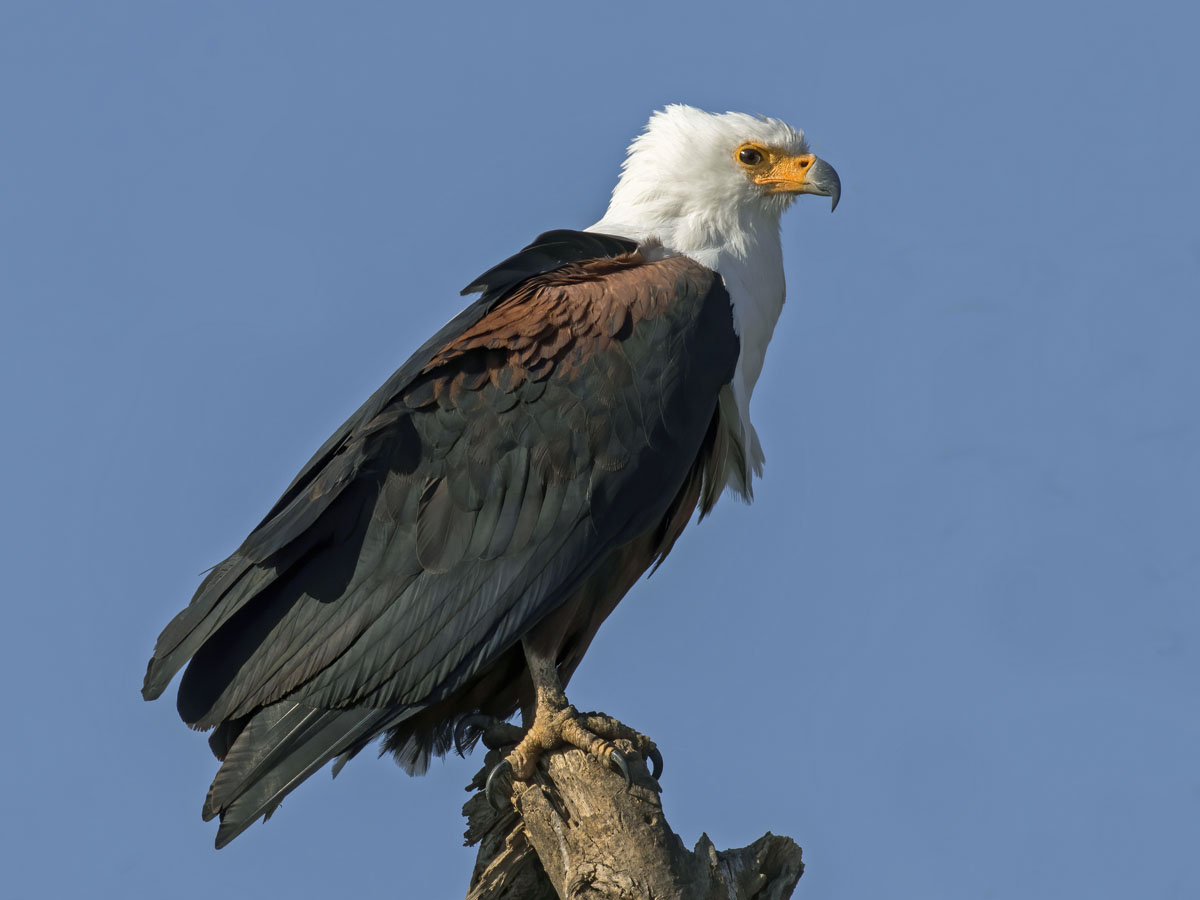

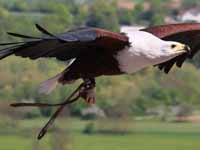
Eagle,_Bald Haliaeetus leucocephalus
Description: The Bald Eagle has mainly dark brown plumage. It has a white head, neck, and wedge shaped tail, The bill and feet are yellow. It can weight over 6 kg, the more northern birds averaging heavier than the southern bald eagles. The juvenile has mainly brown plumage, with some scattered white. The juvenile bald eagle has larger head and larger bill than the similar adult golden eagle.
Range: North America.
Habitat: Near fresh or salt water that has plentiful fish. Perches, roosts, and nests high up in large trees.
Diet: Mainly fish. Also birds, small mammals, and carrion.
Conservation status: Least Concern.
Image by: 1) Rick Leche 2) RoNg - Oregon 3) Dick Daniels - Brookfield Gardens, South Carolina 4) Ted Grussing 5) Andy_Morffew - AlaskaRange: North America.
Habitat: Near fresh or salt water that has plentiful fish. Perches, roosts, and nests high up in large trees.
Diet: Mainly fish. Also birds, small mammals, and carrion.
Conservation status: Least Concern.
1) 2 year 2) 3 year juvenile
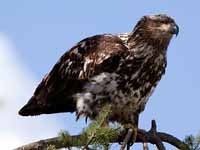
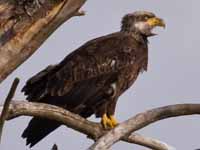

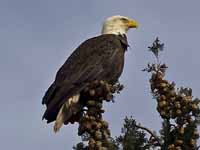
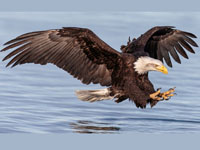
Eagle,_grey-headed Fish- Haliaeetus ichthyaetus
Description: The grey-headed fish-eagle has a grey head. The back and wings are greyish-brown, the breast brown, and the belly white. The white tail has a black terminal band. The grey-headed fish-eagle is larger than the similar lesser fish-eagle.The bold black terminal band of the grey-headed fish-eagle easily differentiates the two species.
Range: Southeast Asia, Indian Subcontinent.
Habitat: Lowland forest near waterbodies.
Diet: Fish, fish carrion. Also mammal, birds, reptiles.
Conservation status: It is listed as Near Threatened because of declining populations.
Image by: 1) Steve Garvie - Sri Lanka 2) Lip Kee - India 3) Soubhagya S Behera - IndiaRange: Southeast Asia, Indian Subcontinent.
Habitat: Lowland forest near waterbodies.
Diet: Fish, fish carrion. Also mammal, birds, reptiles.
Conservation status: It is listed as Near Threatened because of declining populations.
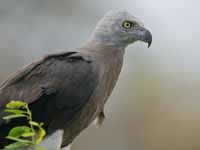
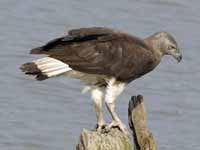
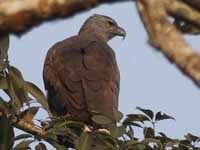
Eagle,_Lesser Fish- Haliaeetus humilis
Description: The lesser fish-eagle has a grey head. The back and wings are greyish-brown. It has a brown breast and white belly. The white tail has an indistinct terminal band and is white tipped. The grey-headed fish-eagle is larger than the similar lesser fish-eagle.The bold black terminal band of the grey-headed fish-eagle easily differentiates the two species.
Range: Indian Subcontinent, Southeast Asia.
Habitat: Forests near waterbodies.
Diet: Fish, fish carrion. Prey is spotted while the eagle is sitting on a midstream rock or on a tree limb.
Conservation status: The species is listed as Near Threatened due to declining population due to habitat destruction such as silting of rivers and overfishing.
Image by: 1) LonelyShrimp 2) Subramanya CK 3) Raman_KumarRange: Indian Subcontinent, Southeast Asia.
Habitat: Forests near waterbodies.
Diet: Fish, fish carrion. Prey is spotted while the eagle is sitting on a midstream rock or on a tree limb.
Conservation status: The species is listed as Near Threatened due to declining population due to habitat destruction such as silting of rivers and overfishing.

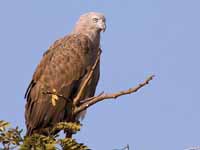
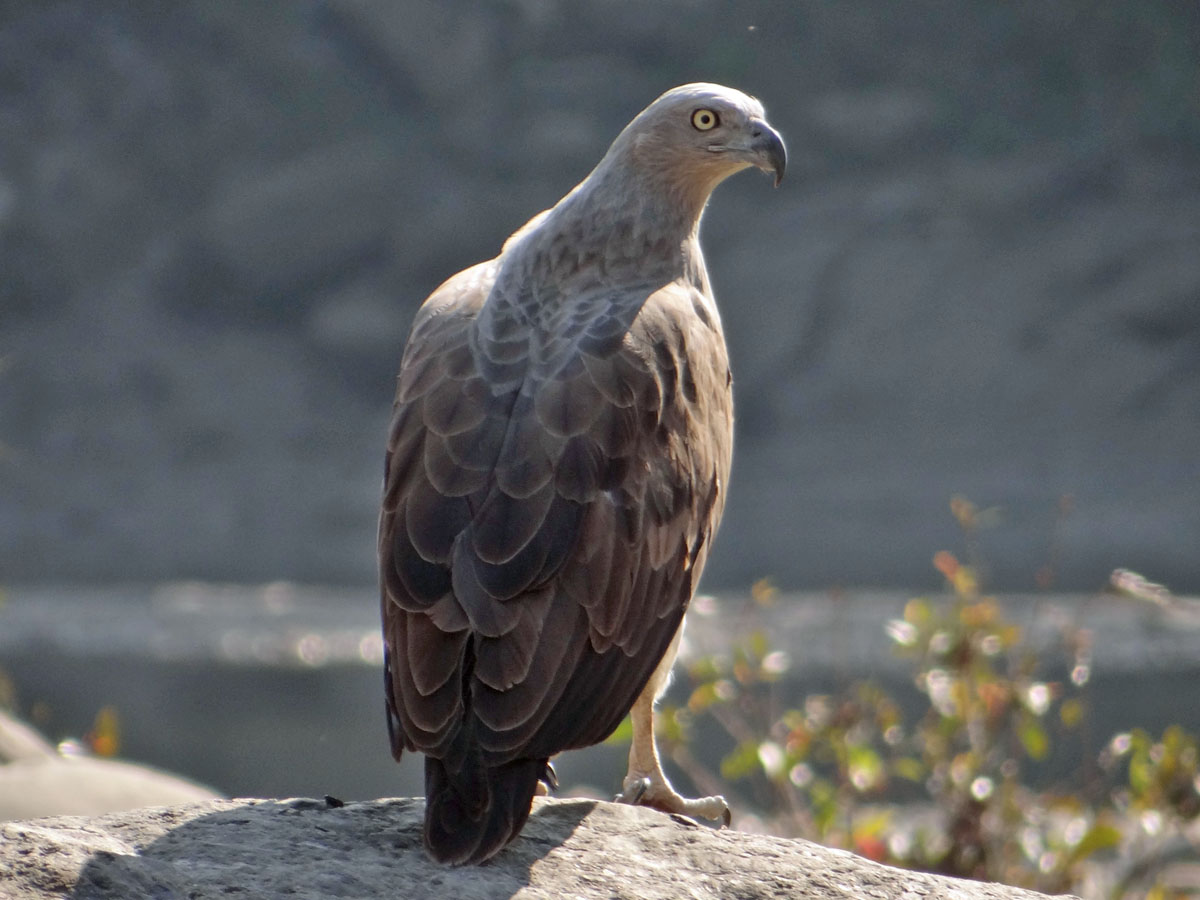
Eagle,_Madagascar Fish- Haliaeetus vociferoides
Description: The Madagascar fish-eagle has mainly dark brown plumage. It has a pale tan head with whitish face and a faint eye-line. The tail is white, the legs are grey, and the blackish bill has a pale base.
Range: Madagascar.
Habitat: Msinly coastal. Perches, roosts, and nests high up in large trees.
Diet: Fish; also crabs, carrion.
Conservation status: The Madagascar fish-eagle is consider Critically Endangered because there are perhaps only 100 breeding pairs. Habit challenges are deforestation, soil erosion, wetlands converted to rice paddies.
Image by: 1) Alan_Hopkins 2) Francesco_Veronesi 3) Frank VassenRange: Madagascar.
Habitat: Msinly coastal. Perches, roosts, and nests high up in large trees.
Diet: Fish; also crabs, carrion.
Conservation status: The Madagascar fish-eagle is consider Critically Endangered because there are perhaps only 100 breeding pairs. Habit challenges are deforestation, soil erosion, wetlands converted to rice paddies.
1) Juvenile
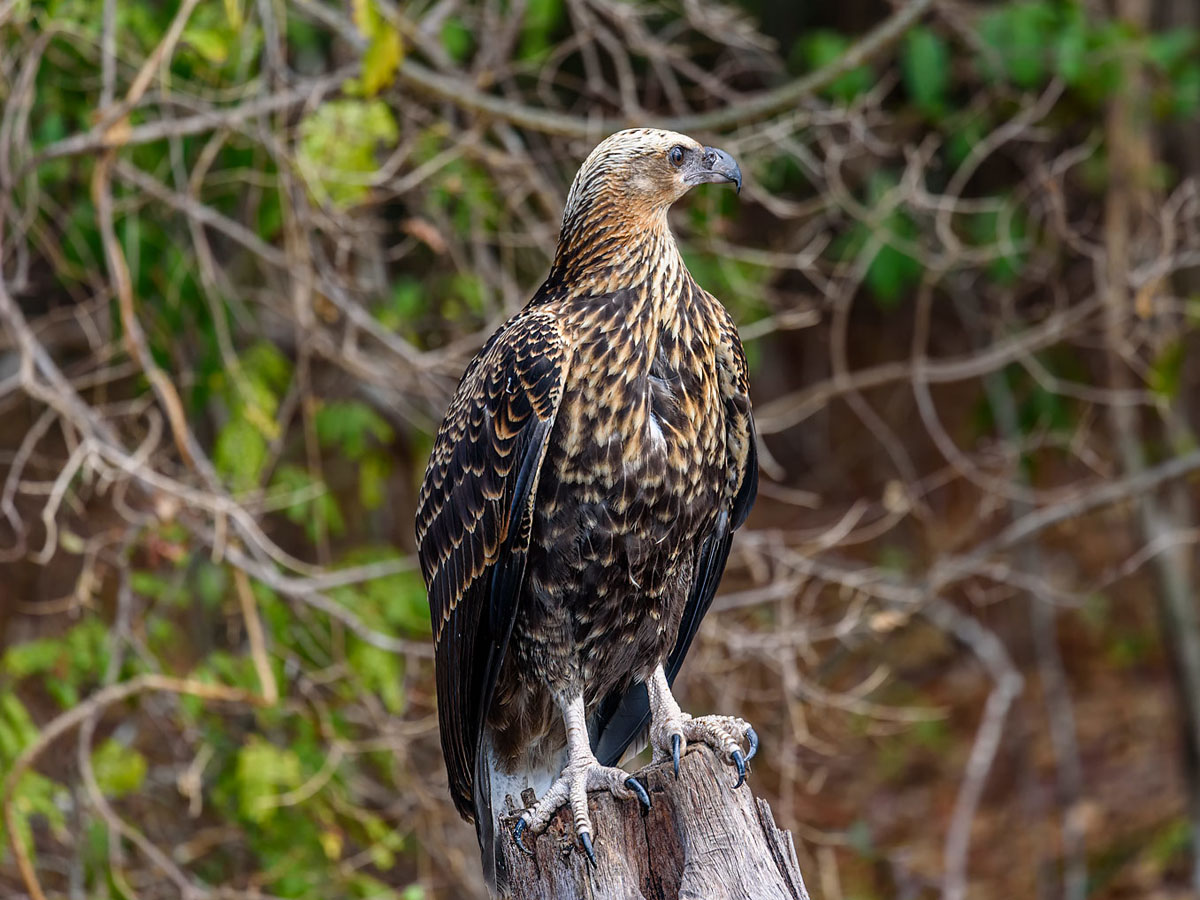


Eagle,_Pallas's Sea- Haliaeetus leucoryphus
Description: The Pallas's fish-eagle, also known as the Pallas's sea-eagle, is a large eagle than can weigh over 3 kg. It has dark brown upperparts, a white face, and brown underparts. The rounded tail has a broad white band. It takes a vulture-like pose.
Range: Asia.
Habitat: Fresh waterbodies. In winter may also visit coastal waters.
Diet: Mainly fish. Also mammals, birds, reptiles.
Conservation status: Pallas's sea-eagle is listed as Endangered. The population is less than 3000 and still declining due to habitat degradation and overfishing.
Image by: 1, 2) Lip Kee Yap - Kazaringa, Assam, India 3) Pankaj Kaushal - India 4) Koshy_Koshy - IndiaRange: Asia.
Habitat: Fresh waterbodies. In winter may also visit coastal waters.
Diet: Mainly fish. Also mammals, birds, reptiles.
Conservation status: Pallas's sea-eagle is listed as Endangered. The population is less than 3000 and still declining due to habitat degradation and overfishing.
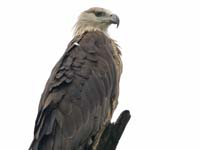

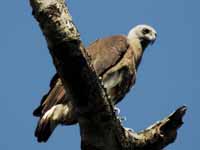
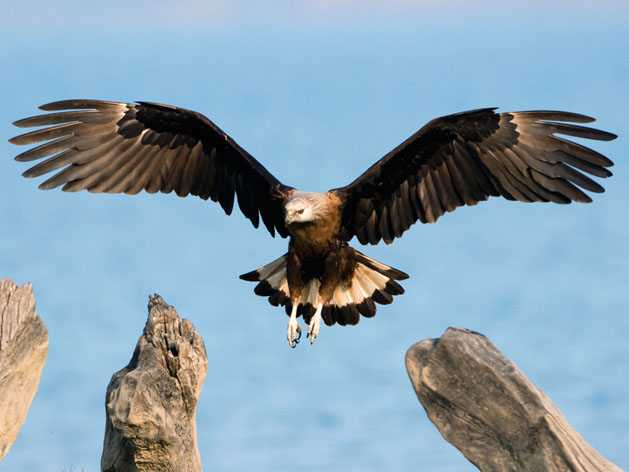
Eagle,_Sanford's_Sea- Haliaeetus sanfordi
Description: The Sanford's's sea-eagle also known as the Sanford fish-eagle, has dark brown to grey-black upperparts, The head and neck are lighter brown. It has brown to reddish brown underparts and a dark tail. It can reach almost 3 kg in weight. It is the largest predator on the Solomon Islands.
Range: Solomon Islands.
Habitat: Prefers coastal forests; also deforested areas.
Diet: Carrion, fish, mollusks, crabs, tortoises, and sea snakes, .
Conservation status: Vulnerable due to deforestation and hunting.
Image by: 1) Katerina_Tvardikova 2) Tony_MorrisRange: Solomon Islands.
Habitat: Prefers coastal forests; also deforested areas.
Diet: Carrion, fish, mollusks, crabs, tortoises, and sea snakes, .
Conservation status: Vulnerable due to deforestation and hunting.
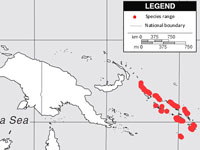

Eagle,_Steller's Sea- Haliaeetus pelagicus Found: Asia
Description: The Steller's Sea-Eagle has mainly dark brown to black plumage; white shoulders, leggings, tail. The bill and feet are yellow. It is lthe largest species of its genus, some females weighing over 9 kg.
Range: Asia - mainly Japan and eastern Russia.
Habitat: Coastal areas as well as inland lakes and spawning rivers.
Diet: Fish. They hunt in shallow waters.
Conservation status: The Steller's sea-eagle is listed as Vulnerable because of habitat alteration, industrial pollution, and overfishing.
Image by: 1) Dmitry Valberg 2) Jorg Hempel 3) Dick Daniels - National Aviary 4) GruenesMonster72 - JapanRange: Asia - mainly Japan and eastern Russia.
Habitat: Coastal areas as well as inland lakes and spawning rivers.
Diet: Fish. They hunt in shallow waters.
Conservation status: The Steller's sea-eagle is listed as Vulnerable because of habitat alteration, industrial pollution, and overfishing.
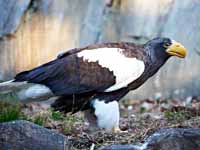
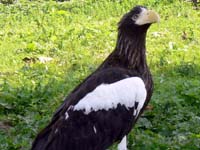


Eagle,_White-bellied Sea- Haliaeetus leucogaster Found:
Description: The white-bellied sea-eagle has dark grey or light grey upperparts. The head, neck, and underparts are white. The flight feathers are black, the wing coverts white.
Range: Southeast Asia, Australia.
Habitat: Wooded or open coastal areas.
Diet: Mammals, fish, birds, carrion. Forages by soaring, low flights, or hunting from a perch.
Conservation status: Least Concern.
Image by: 1) MagicFluet1983 2) Dick Daniels - Featherdale Wildlife Park, Australia 3) Djambalawa - Western AustraliaRange: Southeast Asia, Australia.
Habitat: Wooded or open coastal areas.
Diet: Mammals, fish, birds, carrion. Forages by soaring, low flights, or hunting from a perch.
Conservation status: Least Concern.
4, 5) birdsaspoetry

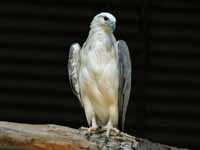
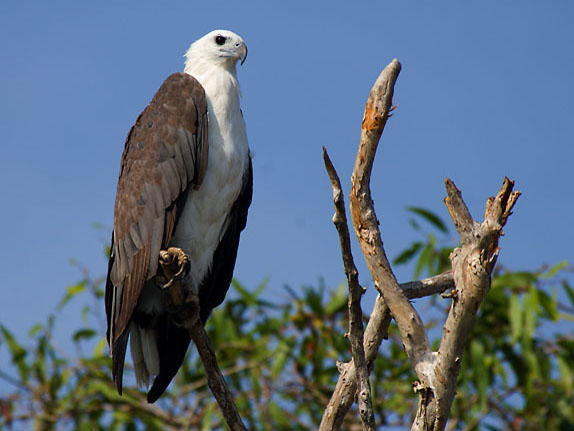
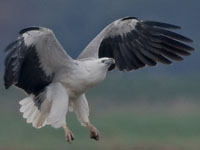
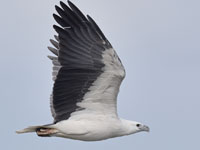
Eagle,_White-tailed Haliaeetus albicilla
Description: The white-tailed eagle has mainly brown plumage with buff head and neck. It has a bold white tail plus yellow eyes and bill. The juvenile has a darker bill and also dark eyes.
Range: Europe, Asia.
Habitat: Usually near coasts or large waterbodies. Nest and roosts on rock cliffs or tall trees.
Diet: Fish, birds. Also small mammals .
Conservation status: Least Concern.
Image by: 1) Jan_Svetlik 2) Jorg Hempel 3) Yathin sk - Norway 4) www.volganet.ru
Range: Europe, Asia.
Habitat: Usually near coasts or large waterbodies. Nest and roosts on rock cliffs or tall trees.
Diet: Fish, birds. Also small mammals .
Conservation status: Least Concern.
1) Adult and juvenile
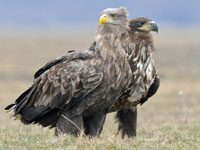
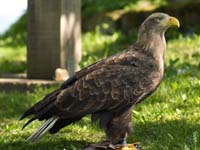
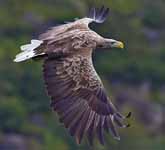
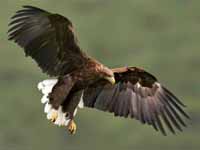
Genus Polemaetus - 1 species
Eagle,_Martial Polemaetus bellicosus
Description: The martial eagle has grey-brown upperparts, brown head and upper-breast. The lower-breast and belly are with some small dark spots.
Range: Sub-Saharan Africa.
Habitat: Open woods and woodland edges, wooded savannah and thornbush habitats.
Diet: Reptiles (especially monitor lizards), mammals, birds. Usually spots prey while soaring.
Conservation status: The martial eagle is Endangered because of hunting, poisoning, reduction of prey.
Image by: 1) Arno
Meintjes 2) Dick Daniels - Radical Raptors in
South Africa 3) Rob_Donnelly 4) Charles_Sharp - ZimbabweRange: Sub-Saharan Africa.
Habitat: Open woods and woodland edges, wooded savannah and thornbush habitats.
Diet: Reptiles (especially monitor lizards), mammals, birds. Usually spots prey while soaring.
Conservation status: The martial eagle is Endangered because of hunting, poisoning, reduction of prey.
1) Juvenile
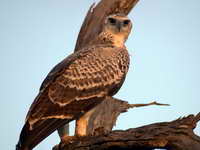

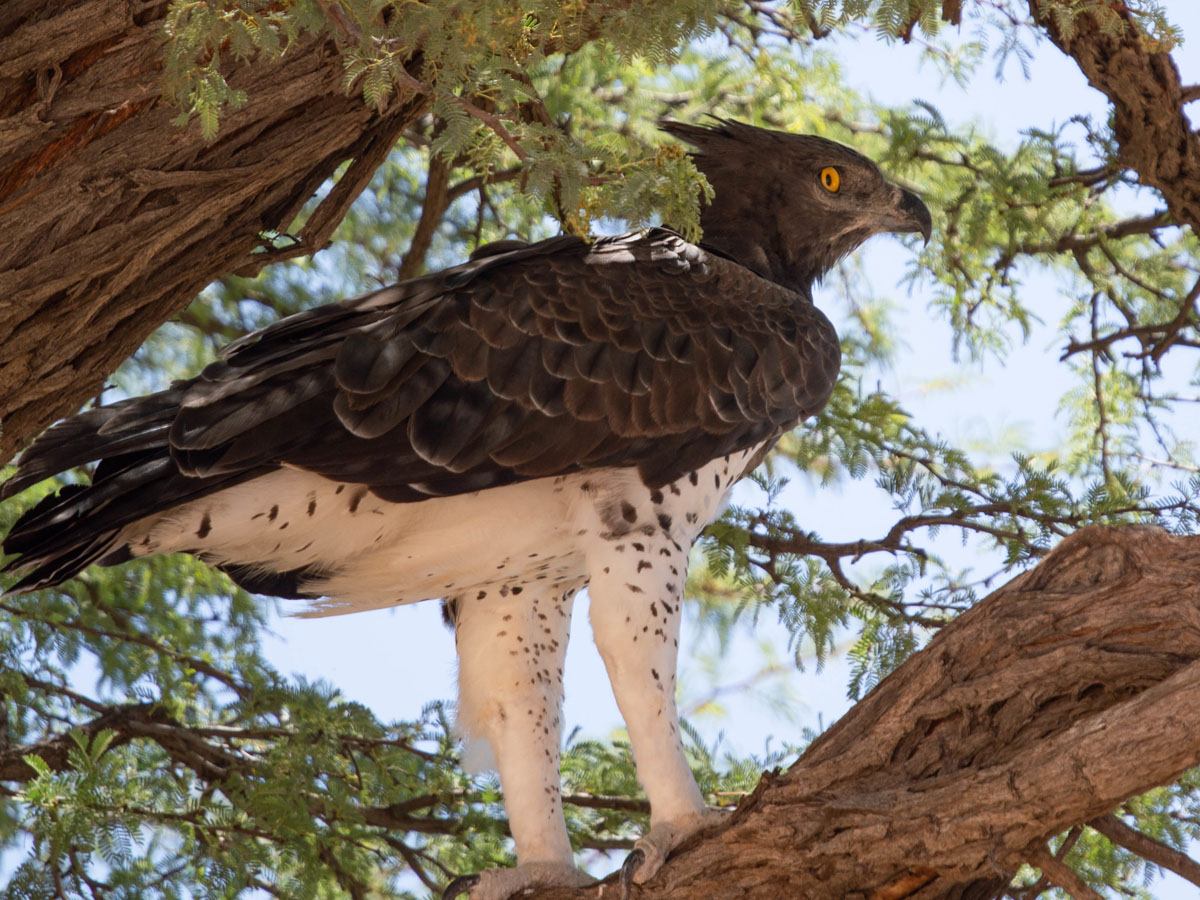

Genus Pandion
The osprey and owls (Strigiformes) are the only hunters whose outer toe is reversible, allowing them to grasp their prey with two toes in front and two behind. This is particularly helpful when they grasp slippery fish. Some divide the ospreys from Australasian into a separate species, the eastern osprey (Pandion cristatus). That will not be done here.
Osprey Pandion haliaetus
Description: The (western) osprey has brown upperparts, a dark eye-line which reaches to the nape and a dark grey bill. The; breast is white and is sometimes streaked with brown. The belly is pure white.Its maximum weight is a little over 2 kg. After the peregrine falcon, the osprey is the most widely distributed raptor.
Range: all continents except Antarctica.
Habitat: Relatively close to water. Nests on trees or platforms.
Diet: Fish which they catch by plunge diving. The fish is carried facing into the wind so it is aerodynamic.
Conservation status: Least Concern.
Image by: 1) Dick Daniels - Florida 2, 3) Dick - North Carolina Range: all continents except Antarctica.
Habitat: Relatively close to water. Nests on trees or platforms.
Diet: Fish which they catch by plunge diving. The fish is carried facing into the wind so it is aerodynamic.
Conservation status: Least Concern.
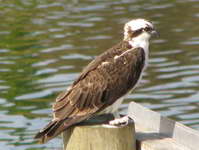
_RWD.jpg)

This family has only one species.
Secretarybird Sagittarius serpentarius
Description: The secretarybird, named for the quill like feathers on the back of its neck, has mostly grey plumage. It has a black nape, wings, belly, and leg feathers. The face is mostly bare with reddish-orange skin. The legs are pink and very long, almost like stilts. It has an eagle like body on crane like legs. Its height can be over 4 ft (1.3 m). The secretarybird's closest relatives are the orprey plus kites, hawks, and eagles. They normally built their nest in trees.
Range: Sub-Saharan Africa.
Habitat: Savanna.
Diet: Insects, mammals, snakes, small birds. It hunts by walking slowly through the grass and uses its feet for killing the prey.
Conservation status: The secretarybird is lised as Endangered because its population is declining as bush is replacing grass in some of its habitat area.
Image by: 1) Carol Foil -Rift Valley, Kenya 2) Brian
Ralphs 3) DIck Daniels - Tanzania 4) Dick - Nairobi National Park, Kenya Stephen_Temple - South AfricaRange: Sub-Saharan Africa.
Habitat: Savanna.
Diet: Insects, mammals, snakes, small birds. It hunts by walking slowly through the grass and uses its feet for killing the prey.
Conservation status: The secretarybird is lised as Endangered because its population is declining as bush is replacing grass in some of its habitat area.

